Paul van Yperen's Blog, page 298
August 25, 2017
Vom Werden deutscher Filmkunst, Part 4
Women are central in the fourth post on our (incomplete) series of collectors cards of Vom Werden deutscher Filmkunst. Ross Verlag published this collectors card series in 1935 for the 'Cigaretten-Bilderdienst', Altona-Bahrenfeld. Ten years earlier women like Henny Porten, Mady Christians and Lil Dagover seemed to rule the German cinema, and a new face arrived, the exquisite Lilian Harvey. In 1935, she would be the Queen of the German cinema.
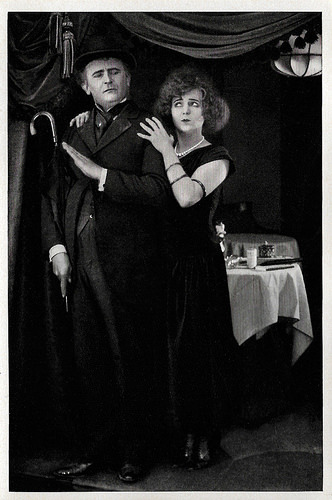
Eugen Klöpfer and Aud Egede Nissen in Die Strasse (1923). German collectors card by Ross Verlag in the series Vom Werden deutscher Filmkunst - Der Stumme Film, picture no. 103, group 43. Photo: Stern-Film. Publicity still for Die Strasse/The Street (Karl Grune, 1923).
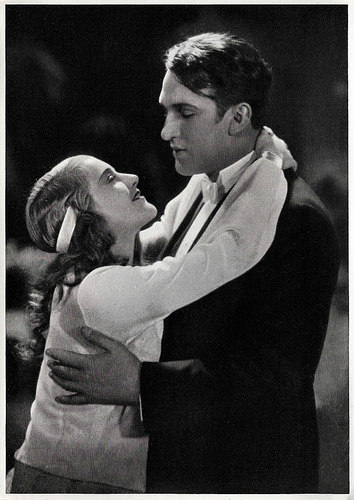
Lien Deyers and Wilhelm Dieterle in Die Heilige und ihr Narr (1928). German collectors card by Ross Verlag in the series Vom Werden deutscher Filmkunst - Der Stumme Film, picture no. 106, Group 40. Photo: Defina. Publicity still with 'Golden' Lien Deyers and Wilhelm Dieterle in Die Heilige und ihr Narr/The Saint and Her Fool (Wilhelm Dieterle, 1928).
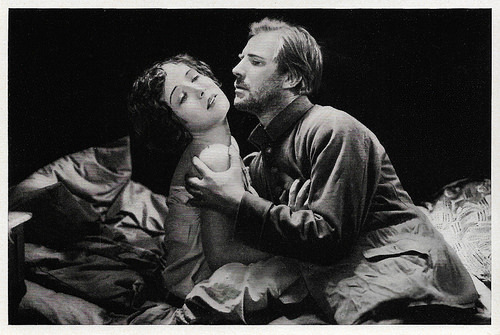
Dita Parlo and Lars Hanson in Heimkehr (1928). German collectors card by Ross Verlag in the series Vom Werden deutscher Filmkunst - Der Stumme Film, picture no. 107, group 43. Photo: Ufa. Publicity still for Heimkehr/Homecoming (Joe May, 1928).
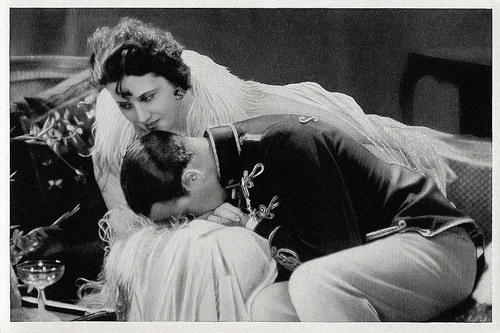
Lil Dagover and Willy Fritsch in Ungarische Rhapsodie (1928). German collectors card by Ross Verlag in the series Vom Werden deutscher Filmkunst - Der Stumme Film, picture no. 111, group 43. Photo: Ufa. Publicity still for Ungarische Rhapsodie/Hungarian Rhapsody (Hanns Schwarz, 1928).
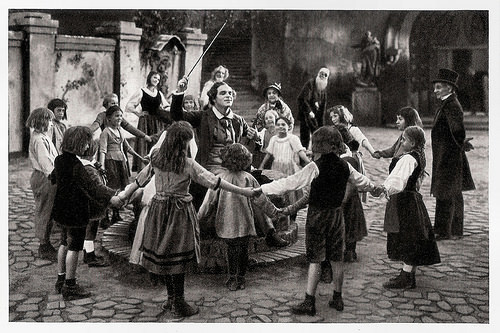
Paul Hartmann in Der Evangelimann (1924). German collectors card by Ross Verlag in the series Vom Werden deutscher Filmkunst - Der Stumme Film, picture no. 113, group 43. Photo: Ufa. Publicity still for Der Evangelimann/The evangelist (Holger-Madsen, 1924). Caption: Paul Hartmann in the filmed Opera 'The Evangelist' by Wilhelm Kienzl.
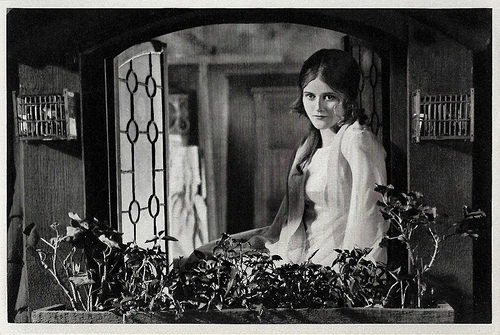
Maria Solveg in Der Meister von Nürnberg (1927). German collectors card by Ross Verlag in the series Vom Werden deutscher Filmkunst - Der Stumme Film, picture no. 114, group 39. Photo: Ufa. Publicity still for Der Meister von Nürnberg/The Master of Nuremberg (Ludwig Berger, 1927).
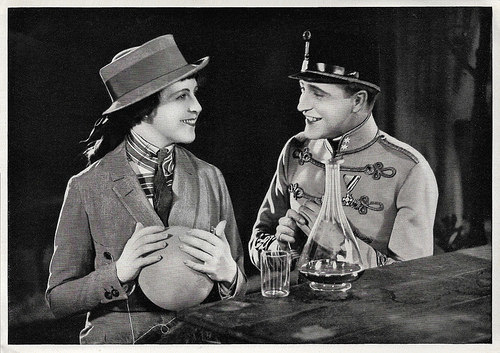
Mady Christians and Willy Fritsch in Ein Walzertraum (1925). German collectors card by Ross Verlag in the series Vom Werden deutscher Filmkunst - Der Stumme Film, picture no. 115, group 40. Photo: Ufa. Publicity still for Ein Walzertraum/A Waltz-Dream (Ludwig Berger, 1925).
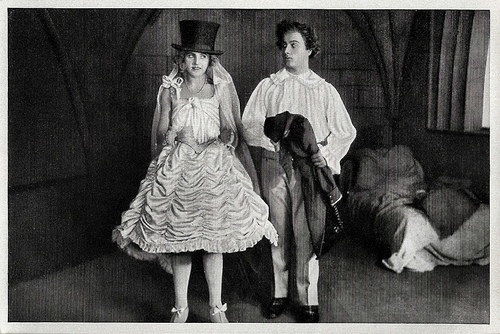
Ossi Oswalda and Hermann Thimig in Die Puppe (1919). German collectors card by Ross Verlag in the series Vom Werden deutscher Filmkunst - Der Stumme Film, picture no. 117, group 39. Photo: Union. Publicity still for Die Puppe/The Doll (Ernst Lubitsch, 1919). Caption: With Die Puppe/The Doll, Lubitsch created a completely new type of comedy for the screen.
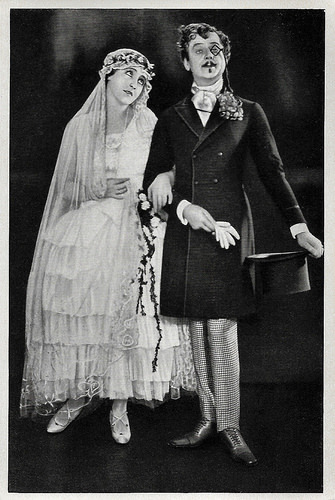
Henny Porten and Ralph Arthur Roberts in Meine Tante, deine Tante (1927). German collectors card by Ross Verlag in the series Vom Werden deutscher Filmkunst - Der Stumme Film, picture no. 118, group 39. Photo: Ufa. Publicity still for Meine Tante - Deine Tante/My Aunt, Your Aunt (Carl Froelich, 1927).
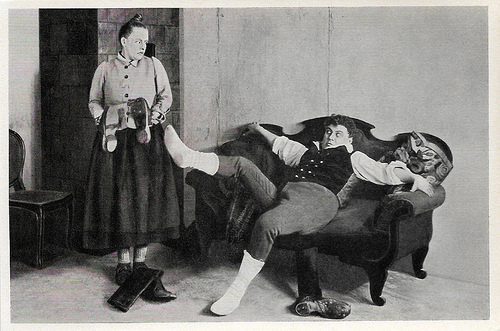
Henny Porten and Emil Jannings in Kohlhiesels Töchter (1920). German collectors card by Ross Verlag in the series Vom Werden deutscher Filmkunst - Der Stumme Film, picture no. 119, group 43. Photo: Ufa. Publicity still for Kohlhiesels Töchter/Kohlhiesel's Daughters (Ernst Lubitsch, 1920).
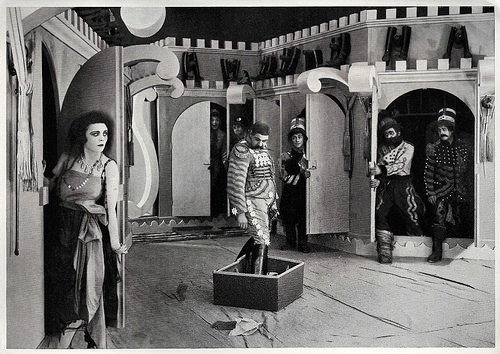
Pola Negri in Die Bergkatze (1921). German collectors card by Ross Verlag in the series Vom Werden deutscher Filmkunst - Der Stumme Film, picture no. 122, group 40. Photo: Ufa. Publicity still for Die Bergkatze/The Wildcat (Ernst Lubitsch, 1921).
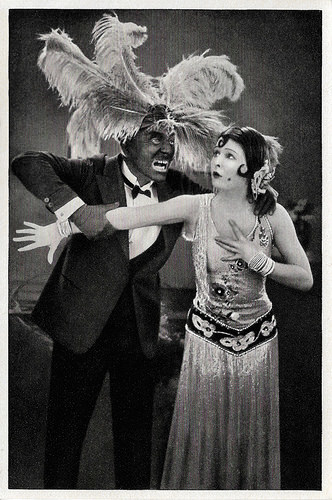
Lilian Harvey and Hans Junkermann in Die tolle Lola (1927). German collectors card by Ross Verlag in the series Vom Werden deutscher Filmkunst - Der Stumme Film, picture no. 123, group 43. Photo: Eichberg-Film. Publicity still for Die tolle Lola/Fabulous Lola (Richard Eichberg, 1927).
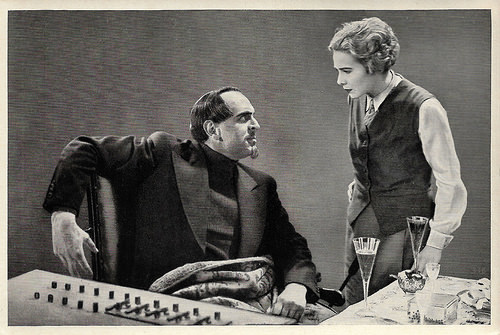
Rudolf Klein-Rogge and Gerda Maurus in Spione (1928). German collectors card by Ross Verlag in the series Vom Werden deutscher Filmkunst - Der Stumme Film, picture no. 124. Photo: Ufa. Publicity still for Spione/Spies (Fritz Lang, 1928).
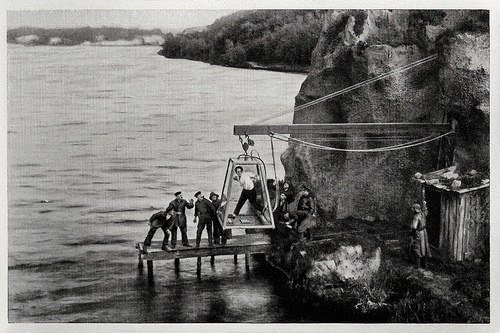
Harry Piel in Rivalen (1923). German collectors card by Ross Verlag in the series Vom Werden deutscher Filmkunst - Der Stumme Film, picture no. 126, group 43. Photo: Harry Piel-Film. Publicity still for Rivalen/Rivals (Harry Piel, 1923).
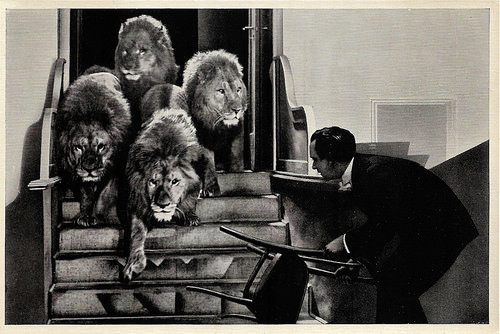
Harry Piel in Panik (1928). German collectors card by Ross Verlag in the series Vom Werden deutscher Filmkunst - Der Stumme Film, picture no. 128. Photo: Ufa. Publicity still with Harry Piel fighting the lions in Panik/Panic (Harry Piel, 1928).
To be continued next Saturday.

Eugen Klöpfer and Aud Egede Nissen in Die Strasse (1923). German collectors card by Ross Verlag in the series Vom Werden deutscher Filmkunst - Der Stumme Film, picture no. 103, group 43. Photo: Stern-Film. Publicity still for Die Strasse/The Street (Karl Grune, 1923).

Lien Deyers and Wilhelm Dieterle in Die Heilige und ihr Narr (1928). German collectors card by Ross Verlag in the series Vom Werden deutscher Filmkunst - Der Stumme Film, picture no. 106, Group 40. Photo: Defina. Publicity still with 'Golden' Lien Deyers and Wilhelm Dieterle in Die Heilige und ihr Narr/The Saint and Her Fool (Wilhelm Dieterle, 1928).

Dita Parlo and Lars Hanson in Heimkehr (1928). German collectors card by Ross Verlag in the series Vom Werden deutscher Filmkunst - Der Stumme Film, picture no. 107, group 43. Photo: Ufa. Publicity still for Heimkehr/Homecoming (Joe May, 1928).

Lil Dagover and Willy Fritsch in Ungarische Rhapsodie (1928). German collectors card by Ross Verlag in the series Vom Werden deutscher Filmkunst - Der Stumme Film, picture no. 111, group 43. Photo: Ufa. Publicity still for Ungarische Rhapsodie/Hungarian Rhapsody (Hanns Schwarz, 1928).

Paul Hartmann in Der Evangelimann (1924). German collectors card by Ross Verlag in the series Vom Werden deutscher Filmkunst - Der Stumme Film, picture no. 113, group 43. Photo: Ufa. Publicity still for Der Evangelimann/The evangelist (Holger-Madsen, 1924). Caption: Paul Hartmann in the filmed Opera 'The Evangelist' by Wilhelm Kienzl.

Maria Solveg in Der Meister von Nürnberg (1927). German collectors card by Ross Verlag in the series Vom Werden deutscher Filmkunst - Der Stumme Film, picture no. 114, group 39. Photo: Ufa. Publicity still for Der Meister von Nürnberg/The Master of Nuremberg (Ludwig Berger, 1927).

Mady Christians and Willy Fritsch in Ein Walzertraum (1925). German collectors card by Ross Verlag in the series Vom Werden deutscher Filmkunst - Der Stumme Film, picture no. 115, group 40. Photo: Ufa. Publicity still for Ein Walzertraum/A Waltz-Dream (Ludwig Berger, 1925).

Ossi Oswalda and Hermann Thimig in Die Puppe (1919). German collectors card by Ross Verlag in the series Vom Werden deutscher Filmkunst - Der Stumme Film, picture no. 117, group 39. Photo: Union. Publicity still for Die Puppe/The Doll (Ernst Lubitsch, 1919). Caption: With Die Puppe/The Doll, Lubitsch created a completely new type of comedy for the screen.

Henny Porten and Ralph Arthur Roberts in Meine Tante, deine Tante (1927). German collectors card by Ross Verlag in the series Vom Werden deutscher Filmkunst - Der Stumme Film, picture no. 118, group 39. Photo: Ufa. Publicity still for Meine Tante - Deine Tante/My Aunt, Your Aunt (Carl Froelich, 1927).

Henny Porten and Emil Jannings in Kohlhiesels Töchter (1920). German collectors card by Ross Verlag in the series Vom Werden deutscher Filmkunst - Der Stumme Film, picture no. 119, group 43. Photo: Ufa. Publicity still for Kohlhiesels Töchter/Kohlhiesel's Daughters (Ernst Lubitsch, 1920).

Pola Negri in Die Bergkatze (1921). German collectors card by Ross Verlag in the series Vom Werden deutscher Filmkunst - Der Stumme Film, picture no. 122, group 40. Photo: Ufa. Publicity still for Die Bergkatze/The Wildcat (Ernst Lubitsch, 1921).

Lilian Harvey and Hans Junkermann in Die tolle Lola (1927). German collectors card by Ross Verlag in the series Vom Werden deutscher Filmkunst - Der Stumme Film, picture no. 123, group 43. Photo: Eichberg-Film. Publicity still for Die tolle Lola/Fabulous Lola (Richard Eichberg, 1927).

Rudolf Klein-Rogge and Gerda Maurus in Spione (1928). German collectors card by Ross Verlag in the series Vom Werden deutscher Filmkunst - Der Stumme Film, picture no. 124. Photo: Ufa. Publicity still for Spione/Spies (Fritz Lang, 1928).

Harry Piel in Rivalen (1923). German collectors card by Ross Verlag in the series Vom Werden deutscher Filmkunst - Der Stumme Film, picture no. 126, group 43. Photo: Harry Piel-Film. Publicity still for Rivalen/Rivals (Harry Piel, 1923).

Harry Piel in Panik (1928). German collectors card by Ross Verlag in the series Vom Werden deutscher Filmkunst - Der Stumme Film, picture no. 128. Photo: Ufa. Publicity still with Harry Piel fighting the lions in Panik/Panic (Harry Piel, 1928).
To be continued next Saturday.
Published on August 25, 2017 22:00
August 24, 2017
Jerry Lewis (1926-2017)
Legendary American comedian, actor and director Jerry Lewis, who died this week at 91, scored in just about every branch of show business: nightclubs, radio, television, concerts, films and records. Lewis rose to fame in a comedy duo with Dean Martin, and his slapstick humour carried him through decades of film, television, stage and radio shows. Jerry was most popular in Europe, especially in France.
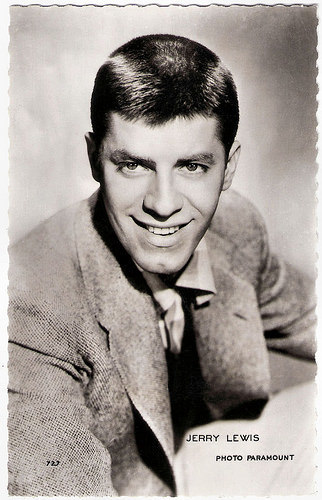
French postcard by Editions P.I., Paris, offered by Les Carbones Korès Carboplane, no. 2 12 G. Photo: Paramount Pictures, 1958.
One of the greatest partnerships in the history of American show business
Jerry Lewis was born Joseph Levitch in 1926, in Newark, New Jersey. He grew up performing in a vaudeville family. His father, Daniel Levitch, who went by the stage name Danny Lewis, was a master of ceremonies and vaudeville entertainer. His mother, Rae Lewis, played piano for the New York City radio station WOR and was her husband's musical director.
Lewis began following in his parents' footsteps, making his debut at the age of 5, singing Brother, Can You Spare a Dime? at 'Borscht Belt' nightclubs in the Catskill Mountains in New York. At the age of 15, Jerry Lewis dropped out of school to pursue a full-time career as a performer. He devised a comedy routine known as the Record Act in which he mimed and mouthed the lyrics to operatic and popular songs while a phonograph played the songs offstage.
Lewis worked as a theatre usher and soda jerk to make ends meet. He grew depressed and was on the verge of giving up on his show-business dreams when a friend of his father's, the comedian Max Coleman, convinced him to give comedy another shot. Lewis soon caught the attention of another comedian, Irving Kaye, who became the young comic's manager and helped his career along through more Borscht Belt appearances.
In 1946, singer Dean Martin joined Lewis as a performer at the 500 Club, and one of the greatest partnerships in the history of American show business was born. Their zany act began with Martin singing a song only to be interrupted by Lewis, with the routine soon devolving into a hilarious improvised sequence that included ad-libbed insults, food fights and frequent banter with the audience.
Billed as Martin and Lewis, the duo became such an instantaneous success that in a matter of months they went from earning $250 a week to a whopping $5,000. They made a successful transition to the big screen with My Friend Irma (George Marshall, 1949), based on the popular radio series of the same name. This was followed by the sequel My Friend Irma Goes West (Hal Walker, 1950).
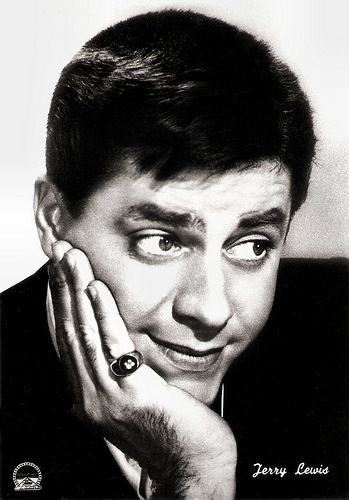
Italian postcard by Bromophoto, Milano, no. 1501. Photo: Paramount Films.
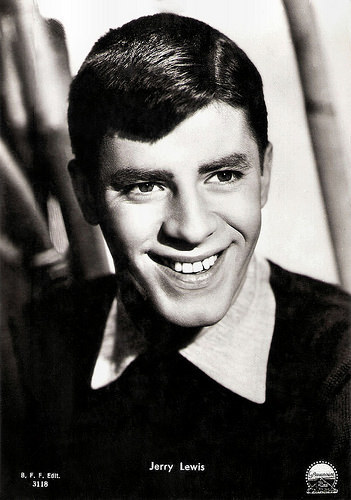
Italian postcard by Casa Editr. Balerini & Fratini, Firenze (Florence), no. 3119. Photo: Paramount Films.
Egotism and insensitivity
Over the next decade, Dean Martin and Jerry Lewis made 16 films together, including The Stooge (Norman Taurog, 1952), The Caddy (Norman Taurog, 1952), Artists and Models (Frank Tashlin, 1955), co-starring Shirley MacLaine and Dorothy Malone, and finally Hollywood or Bust (Frank Tashlin, 1956) with Anita Ekberg .
The pair also made frequent television appearances on The Ed Sullivan Show and The Colgate Comedy Hour. However, by the mid-1950s their partnership and friendship began to fray as Lewis received greater national attention and, as he admitted later, drove Martin away with his egotism and insensitivity. The two split ways, both professionally and personally, in 1956.
Teaming with director Frank Tashlin, whose background as a Warner Bros. Looney Tunes cartoon director suited Lewis's brand of humor, he starred in five more films, The Sad Sack (George Marshall, 1957), Rock-A-Bye Baby (Frank Tashlin, 1958), The Geisha Boy (Frank Tashlin, 1958), Don't Give Up The Ship (Norman Taurog, 1959) and even appeared uncredited as Itchy McRabbitt in Li'l Abner (Melvin Frank, 1959).
Lewis also enjoyed solo success with films like The Delicate Delinquent (Don McGuire, 1957) with Martha Hyer , The Ladies Man (Jerry Lewis, 1961) and The Nutty Professor (Jerry Lewis, 1963) with Stella Stevens. He made his directorial debut with the comedy The Bellboy (Jerry Lewis, 1960). The film marked the pioneering use of a video assist system, providing Lewis a way to see the action even though he was in the scene.
Later Lewis films were Who's Minding the Store? (Frank Tashlin, 1963), The Patsy (Jerry Lewis, 1964) and The Disorderly Orderly (Frank Tashlin, 1964). Lewis directed and co-wrote The Family Jewels (1965) about a young heiress who must choose among six uncles, one of whom is up to no good and out to harm the girl's beloved bodyguard who practically raised her. Lewis played all six uncles and the bodyguard.
Lewis would also appear opposite Tony Curtis and Dany Saval in Boeing Boeing (John Rich, 1965).

Spanish postcard by Archivo Bermejo, no. C. 238, 1964. Photo; Paramount Films. Publicity still for Who's Minding the Store? (Frank Tashlin, 1963).
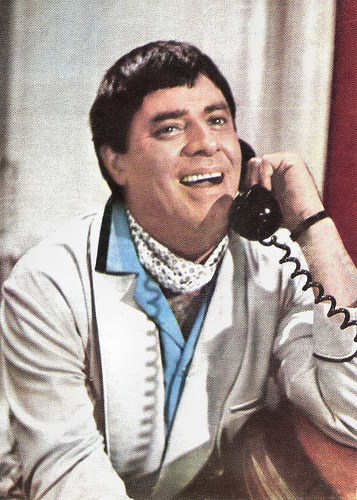
Romanian postcard by Casa Filmului Acin.
The King of Comedy
In 1967 Jerry Lewis began teaching graduate film courses at the University of Southern California. His lectures were collected into a book, The Total Film-Maker (1971), which is considered a seminal text in the industry. In England he made Don't Raise the Bridge, Lower the River (Jerry Paris, 1968) with Terry-Thomas.
His career hit a rough patch in the 1970s, though he remained highly popular in Europe, especially in France. in Sweden he filmed the drama The Day the Clown Cried (Jerry Lewis, 1972), about a German clown who was arrested by the Gestapo, interred in a concentration camp, and used to march Jewish children into the ovens. Reportedly, the film has been tied up in litigation and was never finished. Rough footage exists but a completed version never materialised.
After an absence of a decade, Jerry Lewis returned to the cinema in Hardly Working (Jerry Lewis, 1981), a film which he both directed and starred in. He played an unemployed circus clown who can't seem to hold down a job. The film opens with a brief montage of clips from past Lewis films. Despite being panned by critics, Hardly Working eventually earned $50 million.
Lewis followed this with an acclaimed performance in The King of Comedy (Martin Scorsese, 1982). He portrayed a late night talk-show host who craves his own privacy but is plagued by two obsessive fans, played by Robert De Niro and Sandra Bernhard. Anthony Piggott at IMDb : "Jerry Lewis is perfect as the disgruntled TV host. A man who lives a double-life of hilarious TV personality, with a bitter persona off-screen. You can certainly relate to this man's motivations, his love for his work, but his resistance to allow it run his personal life."
In 1995, Jerry Lewis fulfilled his lifelong dream of acting on Broadway, as the devil in a revival of Damn Yankees. He got good reviews. Lewis was also active in the fight against muscular dystrophy, hosting the annual telethon for the Muscular Dystrophy Association from 1966 to 2010. For his efforts, Lewis was nominated for the Nobel Peace Prize in 1977.
Lewis married Patti Palmer in 1944, and they had six sons together before she filed for divorce in 1980. In 1983, Lewis married SanDee Pitnick, and they adopted a daughter together. Gary Lewis, Jerry Lewis's oldest son, also pursued a show business career as the frontman for the band Gary Lewis and the Playboys. The band had a string of Top 10 hits in the mid-1960s. In 2009, tragedy struck when Joseph Lewis, the youngest of the six children from his first marriage who struggled with drug addiction, committed suicide at age 45.
During his career, he won several awards for lifetime achievements from The American Comedy Awards, Los Angeles Film Critics Association, and Venice Film Festival. In 2009, the Academy of Motion Picture Arts and Sciences awarded Lewis the Jean Hersholt Humanitarian Award.
Jerry Lewis died at his home in Las Vegas on 20 August 2017, at the age of 91. His final film role was as the father of Nicolas Cage in the thriller The Trust (Alex Brewer, Benjamin Brewer, 2016).
Trailer Hollywood or Bust (1956). Source: soapbxprod (YouTube).
Trailer The Nutty Professor (1963). Source: dcaligari (YouTube).
Trailer The King Of Comedy (1983). Source: ryy79 (YouTube).
Sources: Biography.com, Wikipedia and .

French postcard by Editions P.I., Paris, offered by Les Carbones Korès Carboplane, no. 2 12 G. Photo: Paramount Pictures, 1958.
One of the greatest partnerships in the history of American show business
Jerry Lewis was born Joseph Levitch in 1926, in Newark, New Jersey. He grew up performing in a vaudeville family. His father, Daniel Levitch, who went by the stage name Danny Lewis, was a master of ceremonies and vaudeville entertainer. His mother, Rae Lewis, played piano for the New York City radio station WOR and was her husband's musical director.
Lewis began following in his parents' footsteps, making his debut at the age of 5, singing Brother, Can You Spare a Dime? at 'Borscht Belt' nightclubs in the Catskill Mountains in New York. At the age of 15, Jerry Lewis dropped out of school to pursue a full-time career as a performer. He devised a comedy routine known as the Record Act in which he mimed and mouthed the lyrics to operatic and popular songs while a phonograph played the songs offstage.
Lewis worked as a theatre usher and soda jerk to make ends meet. He grew depressed and was on the verge of giving up on his show-business dreams when a friend of his father's, the comedian Max Coleman, convinced him to give comedy another shot. Lewis soon caught the attention of another comedian, Irving Kaye, who became the young comic's manager and helped his career along through more Borscht Belt appearances.
In 1946, singer Dean Martin joined Lewis as a performer at the 500 Club, and one of the greatest partnerships in the history of American show business was born. Their zany act began with Martin singing a song only to be interrupted by Lewis, with the routine soon devolving into a hilarious improvised sequence that included ad-libbed insults, food fights and frequent banter with the audience.
Billed as Martin and Lewis, the duo became such an instantaneous success that in a matter of months they went from earning $250 a week to a whopping $5,000. They made a successful transition to the big screen with My Friend Irma (George Marshall, 1949), based on the popular radio series of the same name. This was followed by the sequel My Friend Irma Goes West (Hal Walker, 1950).

Italian postcard by Bromophoto, Milano, no. 1501. Photo: Paramount Films.

Italian postcard by Casa Editr. Balerini & Fratini, Firenze (Florence), no. 3119. Photo: Paramount Films.
Egotism and insensitivity
Over the next decade, Dean Martin and Jerry Lewis made 16 films together, including The Stooge (Norman Taurog, 1952), The Caddy (Norman Taurog, 1952), Artists and Models (Frank Tashlin, 1955), co-starring Shirley MacLaine and Dorothy Malone, and finally Hollywood or Bust (Frank Tashlin, 1956) with Anita Ekberg .
The pair also made frequent television appearances on The Ed Sullivan Show and The Colgate Comedy Hour. However, by the mid-1950s their partnership and friendship began to fray as Lewis received greater national attention and, as he admitted later, drove Martin away with his egotism and insensitivity. The two split ways, both professionally and personally, in 1956.
Teaming with director Frank Tashlin, whose background as a Warner Bros. Looney Tunes cartoon director suited Lewis's brand of humor, he starred in five more films, The Sad Sack (George Marshall, 1957), Rock-A-Bye Baby (Frank Tashlin, 1958), The Geisha Boy (Frank Tashlin, 1958), Don't Give Up The Ship (Norman Taurog, 1959) and even appeared uncredited as Itchy McRabbitt in Li'l Abner (Melvin Frank, 1959).
Lewis also enjoyed solo success with films like The Delicate Delinquent (Don McGuire, 1957) with Martha Hyer , The Ladies Man (Jerry Lewis, 1961) and The Nutty Professor (Jerry Lewis, 1963) with Stella Stevens. He made his directorial debut with the comedy The Bellboy (Jerry Lewis, 1960). The film marked the pioneering use of a video assist system, providing Lewis a way to see the action even though he was in the scene.
Later Lewis films were Who's Minding the Store? (Frank Tashlin, 1963), The Patsy (Jerry Lewis, 1964) and The Disorderly Orderly (Frank Tashlin, 1964). Lewis directed and co-wrote The Family Jewels (1965) about a young heiress who must choose among six uncles, one of whom is up to no good and out to harm the girl's beloved bodyguard who practically raised her. Lewis played all six uncles and the bodyguard.
Lewis would also appear opposite Tony Curtis and Dany Saval in Boeing Boeing (John Rich, 1965).

Spanish postcard by Archivo Bermejo, no. C. 238, 1964. Photo; Paramount Films. Publicity still for Who's Minding the Store? (Frank Tashlin, 1963).

Romanian postcard by Casa Filmului Acin.
The King of Comedy
In 1967 Jerry Lewis began teaching graduate film courses at the University of Southern California. His lectures were collected into a book, The Total Film-Maker (1971), which is considered a seminal text in the industry. In England he made Don't Raise the Bridge, Lower the River (Jerry Paris, 1968) with Terry-Thomas.
His career hit a rough patch in the 1970s, though he remained highly popular in Europe, especially in France. in Sweden he filmed the drama The Day the Clown Cried (Jerry Lewis, 1972), about a German clown who was arrested by the Gestapo, interred in a concentration camp, and used to march Jewish children into the ovens. Reportedly, the film has been tied up in litigation and was never finished. Rough footage exists but a completed version never materialised.
After an absence of a decade, Jerry Lewis returned to the cinema in Hardly Working (Jerry Lewis, 1981), a film which he both directed and starred in. He played an unemployed circus clown who can't seem to hold down a job. The film opens with a brief montage of clips from past Lewis films. Despite being panned by critics, Hardly Working eventually earned $50 million.
Lewis followed this with an acclaimed performance in The King of Comedy (Martin Scorsese, 1982). He portrayed a late night talk-show host who craves his own privacy but is plagued by two obsessive fans, played by Robert De Niro and Sandra Bernhard. Anthony Piggott at IMDb : "Jerry Lewis is perfect as the disgruntled TV host. A man who lives a double-life of hilarious TV personality, with a bitter persona off-screen. You can certainly relate to this man's motivations, his love for his work, but his resistance to allow it run his personal life."
In 1995, Jerry Lewis fulfilled his lifelong dream of acting on Broadway, as the devil in a revival of Damn Yankees. He got good reviews. Lewis was also active in the fight against muscular dystrophy, hosting the annual telethon for the Muscular Dystrophy Association from 1966 to 2010. For his efforts, Lewis was nominated for the Nobel Peace Prize in 1977.
Lewis married Patti Palmer in 1944, and they had six sons together before she filed for divorce in 1980. In 1983, Lewis married SanDee Pitnick, and they adopted a daughter together. Gary Lewis, Jerry Lewis's oldest son, also pursued a show business career as the frontman for the band Gary Lewis and the Playboys. The band had a string of Top 10 hits in the mid-1960s. In 2009, tragedy struck when Joseph Lewis, the youngest of the six children from his first marriage who struggled with drug addiction, committed suicide at age 45.
During his career, he won several awards for lifetime achievements from The American Comedy Awards, Los Angeles Film Critics Association, and Venice Film Festival. In 2009, the Academy of Motion Picture Arts and Sciences awarded Lewis the Jean Hersholt Humanitarian Award.
Jerry Lewis died at his home in Las Vegas on 20 August 2017, at the age of 91. His final film role was as the father of Nicolas Cage in the thriller The Trust (Alex Brewer, Benjamin Brewer, 2016).
Trailer Hollywood or Bust (1956). Source: soapbxprod (YouTube).
Trailer The Nutty Professor (1963). Source: dcaligari (YouTube).
Trailer The King Of Comedy (1983). Source: ryy79 (YouTube).
Sources: Biography.com, Wikipedia and .
Published on August 24, 2017 22:00
August 23, 2017
Il piccolo scrivano fiorentino (1915)
Last week we did a post on the Italian silent film Naufragio/Shipwreck (Umberto Paradisi, 1915). Like Naufragio, Il piccolo scrivano fiorentino/The little scribe from Florence (Leopoldo Carlucci, 1915) is based on one of the stories from Edmondo De Amicis' book Cuore (Heart, 1886). Child actor Ermanno Roveri is also the star of this film and again the film was produced by Film Artistica Gloria.
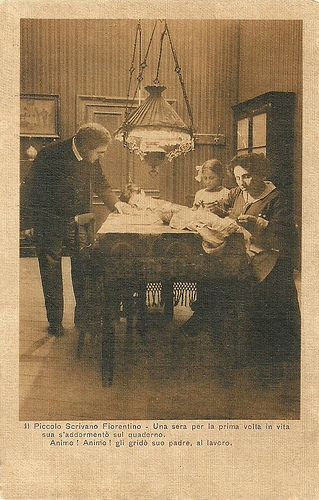
Italian postcard by Film Artistica Gloria, Torino, no. 3386. Photo: publicity still for Il piccolo scrivano fiorentino (Leopoldo Carlucci, 1915). Caption: One night, for the first time in his life, he fell asleep over his notebook. Wake up! Wake up! his father shouted to him, Get to work!
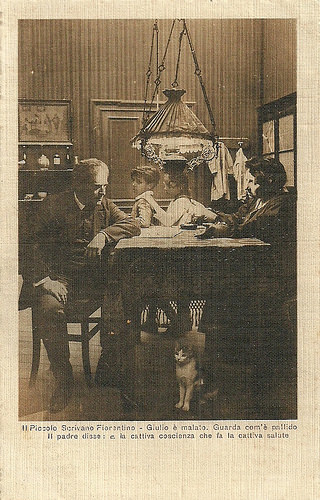
Italian postcard by Film Artistica Gloria, Torino, no. 3386. Photo: publicity still for Il piccolo scrivano fiorentino (Leopoldo Carlucci, 1915). Caption: 'Giulio is ill. Look how pale he is.' His father said: 'It is his bad conscience which gives him bad health.'
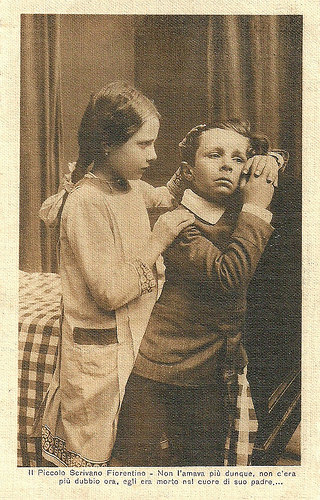
Italian postcard by Film Artistica Gloria, Torino, no. 3386. Photo: publicity still for Il piccolo scrivano fiorentino (Leopoldo Carlucci, 1915). Caption: He didn't love him anymore, there was no doubt now, he was dead in the heart of his father...
The secret of a son
Italian actor Ermanno Roveri started his career as child star, a.o. in the adaptations of the stories from Edmondo De Amicis' novel Cuore, including Il piccolo patriota padovano/The little patriot from Padua (1915), Dagli Appennini alle Ande/From the Apennines to the Andes (Umberto Paradisi, 1916), and Naufragio/Shipwreck (Umberto Paradisi, 1916).
In Il piccolo scrivano fiorentino, Ermanno Roveri plays Giulio, a 12-year old boy from Florence. The boy lacks sleep as he secretly helps his father (Antonio Monti) copying volumes at night.
His parents reproach him, as Giulio loses weight and lacks attention in school. One night, however, the father discovers the secret of his son...
All the Cuore-adaptations were filmed in 1915-1916 for the company Gloria Film in Turin. The stories were set during the Italian unification, and include several patriotic themes.
In the films, the heroes were young Italians who sacrificed themselves for their country and fought against the enemies at all time, even in distant wars. Gloria understood how to support through cinema the war effort during World War I.
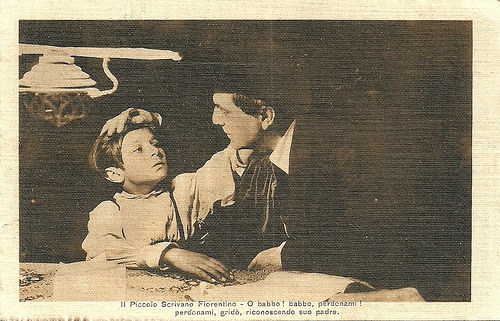
Italian postcard by Film Artistica Gloria, Torino, no. 3386. Photo: publicity still of Ermanno Roveri and Antonio Monti in Il piccolo scrivano fiorentino (Leopoldo Carlucci, 1915). Caption: 'Oh, Daddy! Daddy, forgive me, forgive me!', he cried, recognising his father.
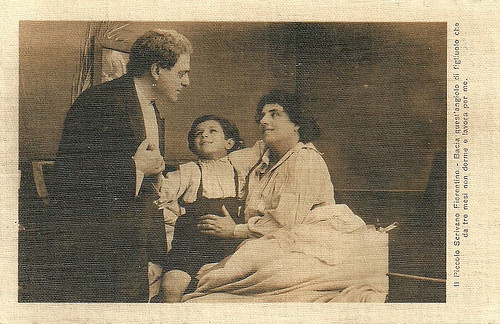
Italian postcard by Film Artistica Gloria, Torino, no. 3386. Photo: publicity still for Il piccolo scrivano fiorentino (Leopoldo Carlucci, 1915). Caption: 'Kiss this dear angel of a son of mine, who for three months hasn't slept and has worked in my place.'
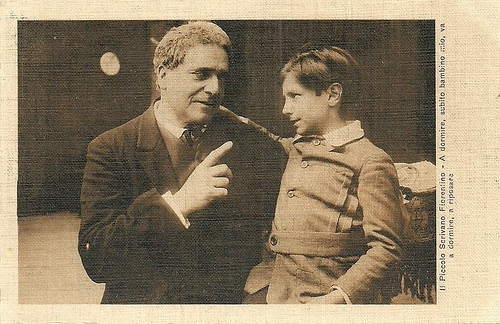
Italian postcard by Film Artistica Gloria, Torino, no. 3386. Photo: publicity still for Il piccolo scrivano fiorentino (Leopoldo Carlucci, 1915). Caption: 'Now go straight to bed, my child, go to sleep and rest.'
Source: Europeana, Wikipedia (Italian and English) and IMDb.

Italian postcard by Film Artistica Gloria, Torino, no. 3386. Photo: publicity still for Il piccolo scrivano fiorentino (Leopoldo Carlucci, 1915). Caption: One night, for the first time in his life, he fell asleep over his notebook. Wake up! Wake up! his father shouted to him, Get to work!

Italian postcard by Film Artistica Gloria, Torino, no. 3386. Photo: publicity still for Il piccolo scrivano fiorentino (Leopoldo Carlucci, 1915). Caption: 'Giulio is ill. Look how pale he is.' His father said: 'It is his bad conscience which gives him bad health.'

Italian postcard by Film Artistica Gloria, Torino, no. 3386. Photo: publicity still for Il piccolo scrivano fiorentino (Leopoldo Carlucci, 1915). Caption: He didn't love him anymore, there was no doubt now, he was dead in the heart of his father...
The secret of a son
Italian actor Ermanno Roveri started his career as child star, a.o. in the adaptations of the stories from Edmondo De Amicis' novel Cuore, including Il piccolo patriota padovano/The little patriot from Padua (1915), Dagli Appennini alle Ande/From the Apennines to the Andes (Umberto Paradisi, 1916), and Naufragio/Shipwreck (Umberto Paradisi, 1916).
In Il piccolo scrivano fiorentino, Ermanno Roveri plays Giulio, a 12-year old boy from Florence. The boy lacks sleep as he secretly helps his father (Antonio Monti) copying volumes at night.
His parents reproach him, as Giulio loses weight and lacks attention in school. One night, however, the father discovers the secret of his son...
All the Cuore-adaptations were filmed in 1915-1916 for the company Gloria Film in Turin. The stories were set during the Italian unification, and include several patriotic themes.
In the films, the heroes were young Italians who sacrificed themselves for their country and fought against the enemies at all time, even in distant wars. Gloria understood how to support through cinema the war effort during World War I.

Italian postcard by Film Artistica Gloria, Torino, no. 3386. Photo: publicity still of Ermanno Roveri and Antonio Monti in Il piccolo scrivano fiorentino (Leopoldo Carlucci, 1915). Caption: 'Oh, Daddy! Daddy, forgive me, forgive me!', he cried, recognising his father.

Italian postcard by Film Artistica Gloria, Torino, no. 3386. Photo: publicity still for Il piccolo scrivano fiorentino (Leopoldo Carlucci, 1915). Caption: 'Kiss this dear angel of a son of mine, who for three months hasn't slept and has worked in my place.'

Italian postcard by Film Artistica Gloria, Torino, no. 3386. Photo: publicity still for Il piccolo scrivano fiorentino (Leopoldo Carlucci, 1915). Caption: 'Now go straight to bed, my child, go to sleep and rest.'
Source: Europeana, Wikipedia (Italian and English) and IMDb.
Published on August 23, 2017 22:00
August 22, 2017
Klaus-Peter Thiele
German actor Klaus-Peter Thiele (1940-2011) was well-known for his film debut in the DEFA production Die Abenteuer des Werner Holt/The Adventures of Werner Holt (1965).

East-German postcard by VEB Progress Film-Vertrieb, Berlin, no. 2399. Photo: Klaus D. Schwarz.

East-German postcard by VEB Progress Film-Vertrieb, Berlin. no. 2261, 1965. Photo: Klaus D. Schwarz.
The DEFA studio in Babelsberg
Klaus-Peter Thiele was born in 1940 in Meiningen, Germany and grew up there. He was the son of actor, director, and artistic director Heino Thiele, who had acted in the German silent cinema. His mother was Elisabeth Seiberlich.
He graduated from drama school in Berlin-Schöneweide and became a cast member of Landestheater Parchim (1960) and the Hansototheater in Potsdam (1964).
Shortly after, director Joachim Kunert, who had met Thiele in drama school, brought him to the DEFA studio in Babelsberg and put him in the title role of his anti-war film Die Abenteuer des Werner Holt/The Adventures of Werner Holt (1965). The film premiered in 1965 in the GDR and 1966 in the Federal Republic with great success.
Another success was the Eastern Weiße Wölfe/White Wolves (Konrad Petzold, Boško Bošković, 1968) about the last Indian war in the USA after 1879. Historical is the outbreak by the Cheyennes from their reserve. The film is a sequel to Spur des Falken/Trail of the Hawk (Gottfried Kolditz, 1966), both starring Gojko Mitic and Barbara Brylska .
During the following years, Thiele participated in numerous film and TV productions, but he never committed to one single genre. Among his films are the children’s film Susanne und der Zauberring/Susanne and the Magic Ring (Erwin Stranka, 1973), the thriller Die Kolonie/The Colony (Horst E. Brandt, 1981), and the fairy tale film Der Bärenhäuter/The Bear (Walter Beck, 1985).

East-German postcard by VEB Progress Film-Vertrieb, Berlin, no. 2118. Photo: Klaus Fischer.

East-German postcard by VEB Progress Film-Vertrieb, Berlin, no. 2943. Photo: Klaus Fischer.

East-German postcard by VEB Progress Film-Vertrieb, Berlin, no. 46/71, 1971. Photo: Linke.
Archives of Death
Unfortunately, Klaus-Peter Thiele was not able to repeat the success of his debut film although he remained an ensemble member of the DEFA and appeared in more than 80 film and television productions. Thus, he frequently had to settle for minor roles.
He often was cast for roles of Nazi characters, for instance in two TV series, directed by Rudi Kurz, Archiv des Todes/Archives of Death (1980) and Front ohne Gnade/Front without Mercy (1984). Both deal with the topic of the fight against fascism during the Nazi regime and both blend contemporary history with a fictional plot.
He also appeared in several Polish films including Pobeda (Evgeniy Matveev, 1985) and Romans z intruzem (Waldemar Podgórski, 1985).
After the Wende (the German reunification) in 1989, Thiele mainly worked at theatres, at first in Hamburg and Munich, later as cast member of the Störtebeker festival in Ralswiek. Volker Wachter at the site Filmstadt Quedlinburg praises the warm and deep voice of the talented actor.
Thiele often appeared on television and was on camera for several TV movies and series, including the popular Krimi series as Polizeiruf 110 (1990, 1997) and Tatort (2002) and the Italian TV film Detective Extralarge: Operazione Condor/Extralarge: Condor Mission (Alessandro Capone, 1993) with Bud Spencer .
In 2011, Klaus-Peter Thiele passed in Berlin away at the age of 70. Thiele lived together with his long-time partner, the painter Rosemarie Rautenberg. Their daughter Valeska Rautenberg, born 1979, also works as an actress and singer.

East-German postcard by VEB Progress Film-Vertrieb, Berlin, no. 2755, 1967. Photo: Klaus D. Schwarz.

Big East-German card by VEB Progress Film-Vertrieb, Berlin, no. 48/70. Photo: Klaus Fischer.

East-German card by VEB Progress Film-Vertrieb, Berlin, no. 142/71. Photo: Günter Linke.
Sources: Volker Wachter (Filmstadt Quedlinburg - German), Filmportal.de, Wikipedia (German) and .

East-German postcard by VEB Progress Film-Vertrieb, Berlin, no. 2399. Photo: Klaus D. Schwarz.

East-German postcard by VEB Progress Film-Vertrieb, Berlin. no. 2261, 1965. Photo: Klaus D. Schwarz.
The DEFA studio in Babelsberg
Klaus-Peter Thiele was born in 1940 in Meiningen, Germany and grew up there. He was the son of actor, director, and artistic director Heino Thiele, who had acted in the German silent cinema. His mother was Elisabeth Seiberlich.
He graduated from drama school in Berlin-Schöneweide and became a cast member of Landestheater Parchim (1960) and the Hansototheater in Potsdam (1964).
Shortly after, director Joachim Kunert, who had met Thiele in drama school, brought him to the DEFA studio in Babelsberg and put him in the title role of his anti-war film Die Abenteuer des Werner Holt/The Adventures of Werner Holt (1965). The film premiered in 1965 in the GDR and 1966 in the Federal Republic with great success.
Another success was the Eastern Weiße Wölfe/White Wolves (Konrad Petzold, Boško Bošković, 1968) about the last Indian war in the USA after 1879. Historical is the outbreak by the Cheyennes from their reserve. The film is a sequel to Spur des Falken/Trail of the Hawk (Gottfried Kolditz, 1966), both starring Gojko Mitic and Barbara Brylska .
During the following years, Thiele participated in numerous film and TV productions, but he never committed to one single genre. Among his films are the children’s film Susanne und der Zauberring/Susanne and the Magic Ring (Erwin Stranka, 1973), the thriller Die Kolonie/The Colony (Horst E. Brandt, 1981), and the fairy tale film Der Bärenhäuter/The Bear (Walter Beck, 1985).

East-German postcard by VEB Progress Film-Vertrieb, Berlin, no. 2118. Photo: Klaus Fischer.

East-German postcard by VEB Progress Film-Vertrieb, Berlin, no. 2943. Photo: Klaus Fischer.

East-German postcard by VEB Progress Film-Vertrieb, Berlin, no. 46/71, 1971. Photo: Linke.
Archives of Death
Unfortunately, Klaus-Peter Thiele was not able to repeat the success of his debut film although he remained an ensemble member of the DEFA and appeared in more than 80 film and television productions. Thus, he frequently had to settle for minor roles.
He often was cast for roles of Nazi characters, for instance in two TV series, directed by Rudi Kurz, Archiv des Todes/Archives of Death (1980) and Front ohne Gnade/Front without Mercy (1984). Both deal with the topic of the fight against fascism during the Nazi regime and both blend contemporary history with a fictional plot.
He also appeared in several Polish films including Pobeda (Evgeniy Matveev, 1985) and Romans z intruzem (Waldemar Podgórski, 1985).
After the Wende (the German reunification) in 1989, Thiele mainly worked at theatres, at first in Hamburg and Munich, later as cast member of the Störtebeker festival in Ralswiek. Volker Wachter at the site Filmstadt Quedlinburg praises the warm and deep voice of the talented actor.
Thiele often appeared on television and was on camera for several TV movies and series, including the popular Krimi series as Polizeiruf 110 (1990, 1997) and Tatort (2002) and the Italian TV film Detective Extralarge: Operazione Condor/Extralarge: Condor Mission (Alessandro Capone, 1993) with Bud Spencer .
In 2011, Klaus-Peter Thiele passed in Berlin away at the age of 70. Thiele lived together with his long-time partner, the painter Rosemarie Rautenberg. Their daughter Valeska Rautenberg, born 1979, also works as an actress and singer.

East-German postcard by VEB Progress Film-Vertrieb, Berlin, no. 2755, 1967. Photo: Klaus D. Schwarz.

Big East-German card by VEB Progress Film-Vertrieb, Berlin, no. 48/70. Photo: Klaus Fischer.

East-German card by VEB Progress Film-Vertrieb, Berlin, no. 142/71. Photo: Günter Linke.
Sources: Volker Wachter (Filmstadt Quedlinburg - German), Filmportal.de, Wikipedia (German) and .
Published on August 22, 2017 22:00
August 21, 2017
Evelyn Künneke
German singer, dancer and actress Evelyn Künneke (1921-2001) was the last survivor of the Lili Marleen generation. Although the Nazis did not like it, she brought tap dance and swing to Germany in the 1930s and 1940s. Thirty years later she made a come-back in the films of Rosa von Praunheim and Rainer Werner Fassbinder.
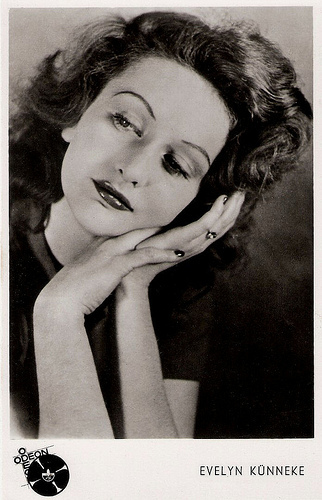
German postcard by Odeon.
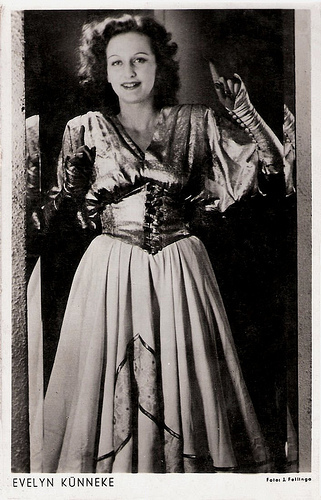
German postcard. Photo: Peter J. Fellinge.
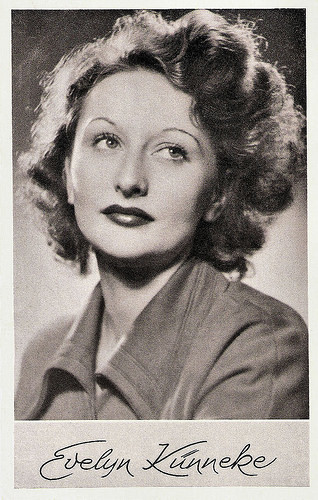
German postcard by Foto-Rauch, Bad Schwalbach.
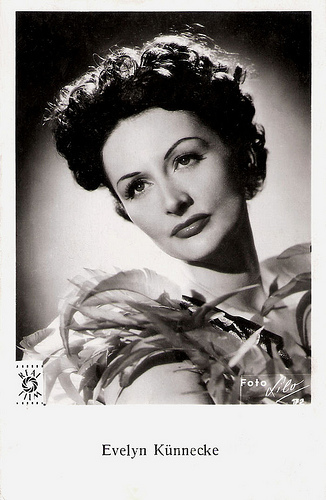
German postcard, no. 172. Photo: Real Film / Lilo.
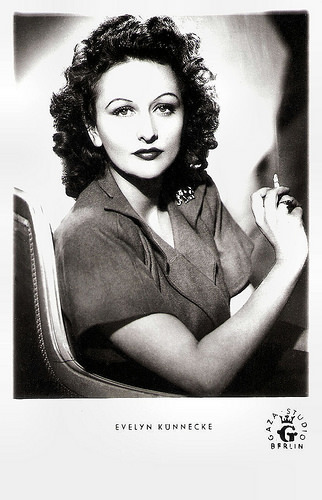
German postcard by Netter's Star Verlag, Berlin, no. A 470. Photo: Gaza Studio, Berlin.
Knock-kneed, Short-sighted, Far Too Tall
Eva-Susanne Künneke was born in Berlin in 1921. She was the daughter of famous operetta composer Eduard Künneke and his wife, the opera singer Katarina Garden (born as Katarina Krapotkin), and she spent her youth very much in the shadow of her father's fame.
Despite the fact that he thought little of his daughter’s artistic talents and despite her being, in her own opinion, "knock-kneed, short-sighted, far too tall, and unable to escape my father's shadow", her ambitions proved irrepressible. She was a swimming champion at 14. She had ballet classes from the Russian choreograph Victor Gsovsky, acting classes from Ilka Grüning, Lucie Höflich and Leslie Howard , and singing lessons from Maria Ivogün. Meanwhile she worked as a photo model.
In Stepstudio Edmont Leslie, she learned to tap dance. In 1935 she acquired the O-level at the Fleckschen private school in Berlin. After completing her education, she became second solo dancer of the Berlin Staatsoper (State Opera), but she made a splash as the tap dancer Evelyn King in Berlin cabarets and variety shows. Only seventeen year old, she toured through Europe as the star of the Scala revue Etwas verrückt (Something Crazy), and that same year she founded together with Horst Matthiesen her own dance studio in Berlin.
A year later, her performances were forbidden by the Nazi regime. After this Berufsverbot she began a career as a singer under the name of Evelyn Künneke. She worked with renowned composers such as Peter Igelhoff and Michael Jary. She also became a starlet at the film studios of the Ufa, where she had her breakthrough in Auf Wiedersehn, Franziska/Goodbye, Franziska (Helmut Käutner, 1941) featuring Marianne Hoppe . In this film she sang Sing, nachtigall, sing (Sing, nightingale, sing), the second most popular hit of wartime Germany after Lale Andersen's Lili Marleen.
Two years later followed an appearance in the film musical Karneval der Liebe/Carnival of Love (Paul Martin, 1943) starring Johannes Heesters . She made frequent tours during the war to support the troops. From 1942 to 1944, she appeared on the eastern front, and in early 1944 also at the western front.
Evelyn Künneke’s hits such as Haben Sie schon mal im Dunkeln geküßt? (Have you ever kissed in the dark?) were unmistakably influenced by the Swing. The American swing music was politically frowned upon in Nazi-Germany and at the time, no other German singer dared to sing Künneke’s kind of songs.
In 1944 she was arrested and accused of defeatism because of her unfavourable observations of the progress of the war and in January 1945 she was put in jail in the Berlin-Tegel prison. It was only the reported intercession of filmmaker Leni Riefenstahl - a personal friend of Adolf Hitler and perhaps the most influential artistic figure in his circle of acquaintances - that prevented worse from happening to her and her family.
Shortly before the end of the war, she was released to sing anti-American Swing songs together with the secret propaganda band Charlie and His Orchestra. The end of the war was the reason she did not have to do this.
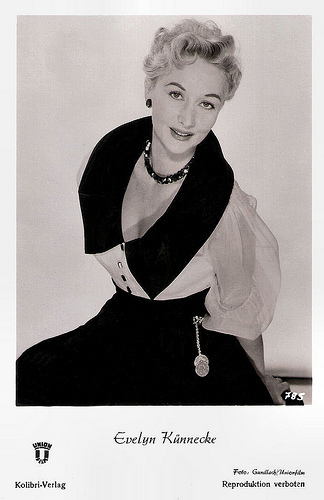
German postcard by Kolibri-Verlag. Photo: Gundlach / Union Film.
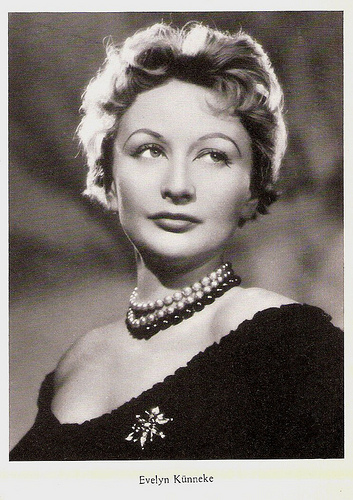
German postcard.
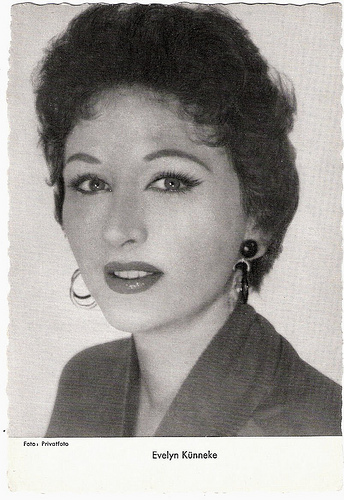
German postcard by WS-Druck, Wanne-Eickel.
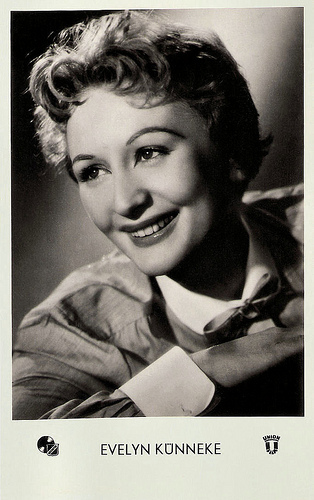
German postcard. Photo: Union Film.
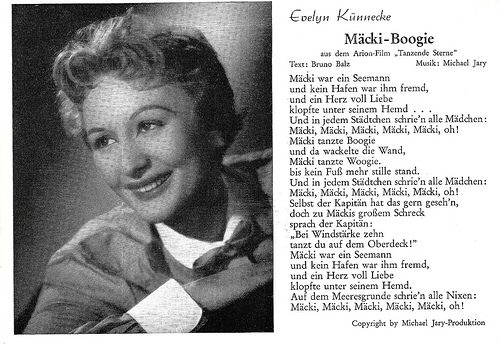
German postcard by Schumann-Verlag, Berlin. Photo: Lilo. Text and music Mäcki-Boogie: Bruno Balz and Michael Jary. From the film Tanzende Sterne/Dancing Stars (Géza von Cziffra, 1952).
Callas of the Subculture
After the war Evelyn Künneke had a few more successful years as a pop singer, first in 1945 with the Show-Orchestra Walter Jenson in Hamburg. Among her hits were Winke-winke (Bye-bye), Allerdings – sprach die Sphinx (However – said the Sphinx) and Egon.
As a singer she appeared in such films as Heimliches Rendezvous/Secret rendezvous (Kurt Hoffmann, 1949) with Hertha Feiler , Die Dritte von rechts/Third from the Right (Géza von Cziffra, 1950) and Die verschleierte Maja/The Veiled Lady (Géza von Cziffra, 1951) with Maria Litto . She played her biggest role till then in Verlorene Melodie/Vanished Melody (Eduard von Borsody, 1952) as an American jazz singer.
She appeared with real swing music in jazz clubs all over Europe. In 1953 she did a tour through the US. Three years later, she celebrated her only hit in the German hit parade, which was only just introduced in 1955: her German-language version of Hernando's Hideaway which reached the 8th place. In 1958 she appeared in the German preliminaries of the Eurovision Song Contest.
In the late 1950s and 1960s, her star faded, and several attempts to establish herself again, failed. In the mid-1970s, Künneke celebrated her big comeback as an actress in the films by the new wave of German directors.
She first appeared with Rainer Werner Fassbinder in 1 Berlin-Harlem (Lothar Lambert, Wolfram Zobus, 1974). For Rosa von Praunheim she appeared in the TV film Axel von Auersperg (Rosa von Praunheim, 1974) and Monolog eines Stars/Monologue of a Star (Rosa von Praunheim, 1975). Fassbinder then directed her in Faustrecht der Freiheit/Fox and his Friends (Rainer Werner Fassbinder, 1975) with Peter Chatel and Karlheinz Böhm .
Künneke could also be seen with David Bowie in Schöner Gigolo, armer Gigolo/Just a Gigolo (David Hemmings, 1978). In total the ‘Callas of the subculture’ would appear in 45 films. Among her later films are the Thomas Mann adaptation Der Zauberberg/The Magic Mountain (Hans W. Geissendörfer, 1982) with Rod Steiger, Neurosia - 50 Jahre pervers/Neurosia (Rosa von Praunheim, 1995) - the autobiography of the director, and the horror comedy Kondom des Grauens/Killer Condom (Martin Walz, 1996), based on the comic book by Ralph König.
She also recorded the albums Sensationell (1975, Sensational), Evelyn II (1976) and Sing, Evelyn, sing! – Das Beste von Evelyn Künneke (1978, Sing, Evelyn, sing! - The Best of Evelyn Künneke).
Till at a very old age, she popped us as a chanteuse in the Berlin scene, often together with Brigitte Mira and Helen Vita as Drei Alte Schachteln (Three old hags). In their popular revue ‘the three last survivors of the Lili Marleen generation’ promoted themselves saying: “Was wollt ihr mit drei knödelnden Tenören, hier habt ihr drei echte Berliner Gören” (What do you need three dumpling tenors for, here you have three real Berlin gals). The three singers had a combined age of just about 240 years, they gleefully informed the public at their sell-out performances.
In 2001, Evelyn Künneke died of lung cancer in her hometown Berlin. She was 79. Künneke had first been married to an Englishman, the father of her daughter. Her second husband was the business school graduate Reinhard Thomanek from 1963 to 1972. Her third marriage was in 1979 with her manager Dieter Hatje. In 2000 she was honoured with the Goldenen Kamera for her long career.
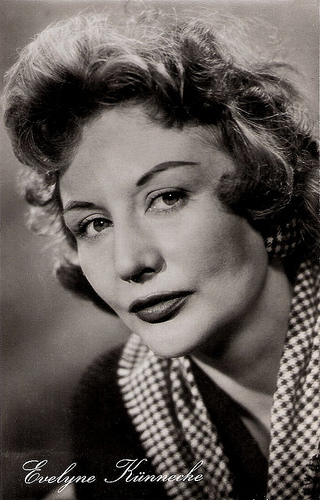
East-German postcard by VEB Progress Film-Vertrieb, no. 70/469, 1957. Photo: DEFA. Publicity still for Meine Frau macht musik/My Wife Wants to Sing (Hans Heinrich, 1958).
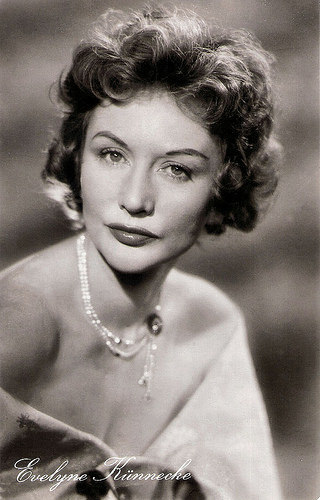
East-German postcard by VEB Progress Film-Vertrieb, no. 71/400. Photo: DEFA / Neufeld. Publicity still for Meine Frau macht Musik/My Wife Wants to Sing (Hans Heinrich, 1958).
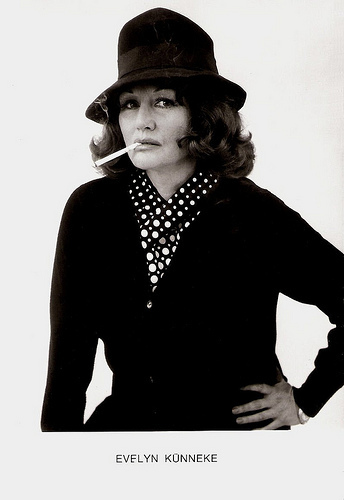
German postcard by Franz Josef Rüdel, Filmpostkartenverlag, Hamburg. Photo: Claus Zeunert.
Evelyn Künneke step-dances in Karneval der Liebe/Carnival of Love (1943). Propaganda Minister Joseph Goebbels declared that this dance sequence was 'Ungerman and not good for moral'. So the scene was cut from the film and and a new sequence with Johannes Heesters and Dorit Kreysler singing Junger Mann was filmed. In the past both film versions were broadcasted on German TV. The last 10 years only the version with Evelyn's dance has been shown. Source: Alparfan (YouTube).
Recording of Sing Nachtigall Sing. Source: MrDeanMartin (YouTube).
Recording of Allerdings, sprach die Sphinx (1949). Source: Annanthrax (YouTube).
Recording of Meine Stadt (1987). Source: Annanthrax (YouTube).
Sources: Bruce Eder (All Music), Philipp Blom (The Independent), Stephanie D'heil (Steffi-line - German), Laut.de (German), Wikipedia (German) and .

German postcard by Odeon.

German postcard. Photo: Peter J. Fellinge.

German postcard by Foto-Rauch, Bad Schwalbach.

German postcard, no. 172. Photo: Real Film / Lilo.

German postcard by Netter's Star Verlag, Berlin, no. A 470. Photo: Gaza Studio, Berlin.
Knock-kneed, Short-sighted, Far Too Tall
Eva-Susanne Künneke was born in Berlin in 1921. She was the daughter of famous operetta composer Eduard Künneke and his wife, the opera singer Katarina Garden (born as Katarina Krapotkin), and she spent her youth very much in the shadow of her father's fame.
Despite the fact that he thought little of his daughter’s artistic talents and despite her being, in her own opinion, "knock-kneed, short-sighted, far too tall, and unable to escape my father's shadow", her ambitions proved irrepressible. She was a swimming champion at 14. She had ballet classes from the Russian choreograph Victor Gsovsky, acting classes from Ilka Grüning, Lucie Höflich and Leslie Howard , and singing lessons from Maria Ivogün. Meanwhile she worked as a photo model.
In Stepstudio Edmont Leslie, she learned to tap dance. In 1935 she acquired the O-level at the Fleckschen private school in Berlin. After completing her education, she became second solo dancer of the Berlin Staatsoper (State Opera), but she made a splash as the tap dancer Evelyn King in Berlin cabarets and variety shows. Only seventeen year old, she toured through Europe as the star of the Scala revue Etwas verrückt (Something Crazy), and that same year she founded together with Horst Matthiesen her own dance studio in Berlin.
A year later, her performances were forbidden by the Nazi regime. After this Berufsverbot she began a career as a singer under the name of Evelyn Künneke. She worked with renowned composers such as Peter Igelhoff and Michael Jary. She also became a starlet at the film studios of the Ufa, where she had her breakthrough in Auf Wiedersehn, Franziska/Goodbye, Franziska (Helmut Käutner, 1941) featuring Marianne Hoppe . In this film she sang Sing, nachtigall, sing (Sing, nightingale, sing), the second most popular hit of wartime Germany after Lale Andersen's Lili Marleen.
Two years later followed an appearance in the film musical Karneval der Liebe/Carnival of Love (Paul Martin, 1943) starring Johannes Heesters . She made frequent tours during the war to support the troops. From 1942 to 1944, she appeared on the eastern front, and in early 1944 also at the western front.
Evelyn Künneke’s hits such as Haben Sie schon mal im Dunkeln geküßt? (Have you ever kissed in the dark?) were unmistakably influenced by the Swing. The American swing music was politically frowned upon in Nazi-Germany and at the time, no other German singer dared to sing Künneke’s kind of songs.
In 1944 she was arrested and accused of defeatism because of her unfavourable observations of the progress of the war and in January 1945 she was put in jail in the Berlin-Tegel prison. It was only the reported intercession of filmmaker Leni Riefenstahl - a personal friend of Adolf Hitler and perhaps the most influential artistic figure in his circle of acquaintances - that prevented worse from happening to her and her family.
Shortly before the end of the war, she was released to sing anti-American Swing songs together with the secret propaganda band Charlie and His Orchestra. The end of the war was the reason she did not have to do this.

German postcard by Kolibri-Verlag. Photo: Gundlach / Union Film.

German postcard.

German postcard by WS-Druck, Wanne-Eickel.

German postcard. Photo: Union Film.

German postcard by Schumann-Verlag, Berlin. Photo: Lilo. Text and music Mäcki-Boogie: Bruno Balz and Michael Jary. From the film Tanzende Sterne/Dancing Stars (Géza von Cziffra, 1952).
Callas of the Subculture
After the war Evelyn Künneke had a few more successful years as a pop singer, first in 1945 with the Show-Orchestra Walter Jenson in Hamburg. Among her hits were Winke-winke (Bye-bye), Allerdings – sprach die Sphinx (However – said the Sphinx) and Egon.
As a singer she appeared in such films as Heimliches Rendezvous/Secret rendezvous (Kurt Hoffmann, 1949) with Hertha Feiler , Die Dritte von rechts/Third from the Right (Géza von Cziffra, 1950) and Die verschleierte Maja/The Veiled Lady (Géza von Cziffra, 1951) with Maria Litto . She played her biggest role till then in Verlorene Melodie/Vanished Melody (Eduard von Borsody, 1952) as an American jazz singer.
She appeared with real swing music in jazz clubs all over Europe. In 1953 she did a tour through the US. Three years later, she celebrated her only hit in the German hit parade, which was only just introduced in 1955: her German-language version of Hernando's Hideaway which reached the 8th place. In 1958 she appeared in the German preliminaries of the Eurovision Song Contest.
In the late 1950s and 1960s, her star faded, and several attempts to establish herself again, failed. In the mid-1970s, Künneke celebrated her big comeback as an actress in the films by the new wave of German directors.
She first appeared with Rainer Werner Fassbinder in 1 Berlin-Harlem (Lothar Lambert, Wolfram Zobus, 1974). For Rosa von Praunheim she appeared in the TV film Axel von Auersperg (Rosa von Praunheim, 1974) and Monolog eines Stars/Monologue of a Star (Rosa von Praunheim, 1975). Fassbinder then directed her in Faustrecht der Freiheit/Fox and his Friends (Rainer Werner Fassbinder, 1975) with Peter Chatel and Karlheinz Böhm .
Künneke could also be seen with David Bowie in Schöner Gigolo, armer Gigolo/Just a Gigolo (David Hemmings, 1978). In total the ‘Callas of the subculture’ would appear in 45 films. Among her later films are the Thomas Mann adaptation Der Zauberberg/The Magic Mountain (Hans W. Geissendörfer, 1982) with Rod Steiger, Neurosia - 50 Jahre pervers/Neurosia (Rosa von Praunheim, 1995) - the autobiography of the director, and the horror comedy Kondom des Grauens/Killer Condom (Martin Walz, 1996), based on the comic book by Ralph König.
She also recorded the albums Sensationell (1975, Sensational), Evelyn II (1976) and Sing, Evelyn, sing! – Das Beste von Evelyn Künneke (1978, Sing, Evelyn, sing! - The Best of Evelyn Künneke).
Till at a very old age, she popped us as a chanteuse in the Berlin scene, often together with Brigitte Mira and Helen Vita as Drei Alte Schachteln (Three old hags). In their popular revue ‘the three last survivors of the Lili Marleen generation’ promoted themselves saying: “Was wollt ihr mit drei knödelnden Tenören, hier habt ihr drei echte Berliner Gören” (What do you need three dumpling tenors for, here you have three real Berlin gals). The three singers had a combined age of just about 240 years, they gleefully informed the public at their sell-out performances.
In 2001, Evelyn Künneke died of lung cancer in her hometown Berlin. She was 79. Künneke had first been married to an Englishman, the father of her daughter. Her second husband was the business school graduate Reinhard Thomanek from 1963 to 1972. Her third marriage was in 1979 with her manager Dieter Hatje. In 2000 she was honoured with the Goldenen Kamera for her long career.

East-German postcard by VEB Progress Film-Vertrieb, no. 70/469, 1957. Photo: DEFA. Publicity still for Meine Frau macht musik/My Wife Wants to Sing (Hans Heinrich, 1958).

East-German postcard by VEB Progress Film-Vertrieb, no. 71/400. Photo: DEFA / Neufeld. Publicity still for Meine Frau macht Musik/My Wife Wants to Sing (Hans Heinrich, 1958).

German postcard by Franz Josef Rüdel, Filmpostkartenverlag, Hamburg. Photo: Claus Zeunert.
Evelyn Künneke step-dances in Karneval der Liebe/Carnival of Love (1943). Propaganda Minister Joseph Goebbels declared that this dance sequence was 'Ungerman and not good for moral'. So the scene was cut from the film and and a new sequence with Johannes Heesters and Dorit Kreysler singing Junger Mann was filmed. In the past both film versions were broadcasted on German TV. The last 10 years only the version with Evelyn's dance has been shown. Source: Alparfan (YouTube).
Recording of Sing Nachtigall Sing. Source: MrDeanMartin (YouTube).
Recording of Allerdings, sprach die Sphinx (1949). Source: Annanthrax (YouTube).
Recording of Meine Stadt (1987). Source: Annanthrax (YouTube).
Sources: Bruce Eder (All Music), Philipp Blom (The Independent), Stephanie D'heil (Steffi-line - German), Laut.de (German), Wikipedia (German) and .
Published on August 21, 2017 22:00
August 20, 2017
Ruth Niehaus
Attractive Ruth Niehaus (1925–1994) was a German stage and film actress, who often played the femme fatale or 'the other woman’. She was dubbed the ‘Rita Hayworth of the German film of the 1950s’ and was regarded as a ‘Fräuleinwunder’.

West-German postcard by Kunst und Bild, Berlin, no. I 452. Photo: CCC-Film / Constantin-Film / Grimm. Publicity still for Studentin Helen Willfüer/Helene Willfüer (Rudolf Jugert, 1956).
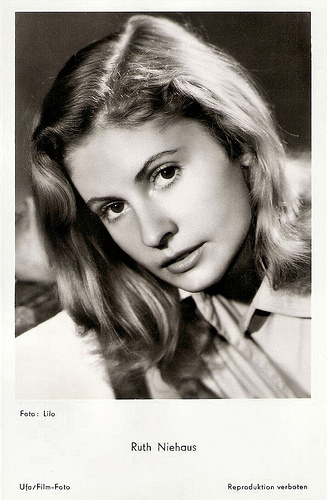
West-German postcard by Ufa, Berlin-Tempelhof, no. FK 4113. Photo: Lilo.
Young, attractive, modern, self-confident and desirable
Ruth Hildegard Rosemarie Niehaus was born in 1925 in Krefeld, Germany. Her parents were Elisabeth Niehaus, born Nettesheim, and the engineer Fritz Niehaus. Her brother was the Munich surgeon Helmut Niehaus.
After completing her high school diploma in Dusseldorf, she attended the drama school there under Peter Esser. Her stage career began at the Stadttheater Krefeld in 1947-1948, followed by engagements at the Deutsche Schauspielhaus in Hamburg (1948-1949), at the Oldenburgische Staatstheater (1949-1950) and in Düsseldorf under the direction of Gustav Gründgens (1952-1954). She played both in classical and modern theatre.
The press called Niehaus a ‘Fräuleinwunder’ a term for young, attractive, modern, self-confident and desirable women of post-war Germany. In 1950 Ruth Niehaus reputedly spurned a marriage proposal from Orson Welles , and with it the chance to work in Hollywood. She did marry Ivar Lissner, a Jewish German journalist and best-selling author, who had been a spy with the German Abwehr during World War II.
Niehaus made her film debut in the West-German comedy Das Haus in Montevideo/The House in Montevideo (1951). It was directed by Curt Goetz and Valérie von Martens who also played the leads, while Niehaus played their daughter. The film is an adaptation of Goetz's 1945 comic play of the same name and Goetz and von Martens had already frequently played their parts on stage.
Niehaus next played a supporting part in Heidelberger Romanze/A Heidelberg Romance (Paul Verhoeven, 1951) starring Liselotte Pulver , O.W. Fischer and Gardy Granass .
She then had the lead in the Heimatfilm Rosen blühen auf dem Heidegrab/Roses Bloom on the Moorland (Hans H. König, 1952). Wikipedia : “This unusually gloomy Heimatfilm, which clearly stood out from the ‘Kinokonfektion’ of the era, is one of the high points in Niehaus's film career.”
She then co-starred with Ivan Desny and René Deltgen in the drama Weg ohne Umkehr/No Way Back (Victor Vicas, 1953). It was made at the height of the Cold War. In 1945 following the Battle of Berlin, a Red Army officer (Desny) is able to protect a young German woman (Niehaus) he finds living in a cellar. Several years later he returns to the city as a civilian, finds her again and makes plans to flee from East to West Germany under the noses of the KGB. For this role she won in 1954 the Bundesfilmpreis (German Film Award).
Other films followed, such as Rosenmontag/Love's Carnival (Willy Birgel, 1955) with Dietmar Schönherr , and Auferstehung/Resurrection (Rolf Hansen, 1958) starring Horst Buchholz .
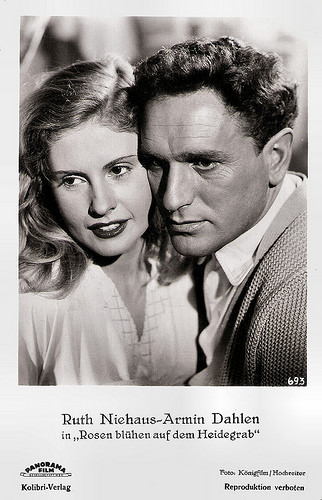
West-German postcard by Kolibri-Verlag, no. 693. Photo: Panorama-Film / Königfilm / Hochreiter. Publicity still for Rosen blühen auf dem Heidegrab/Roses Bloom on the Moorland (Hans H. König, 1952) with Armin Dahlen.
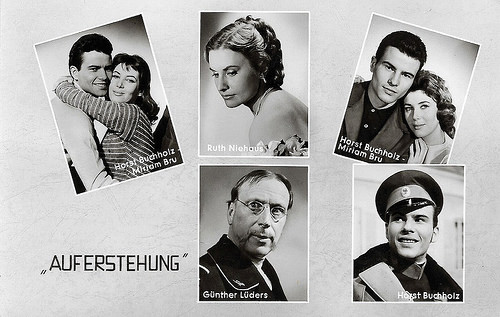
German postcard by Franz Josef Rüdel, Filmpostkartenverlag Hamburg-Bergedorf, no. M 2482. Photo: Ringpress / Vogelmann / Bavaria. Publicity stills for Auferstehung/Resurrection (Rolf Hansen, 1958) with Horst Buchholz , Myriam Bru , Ruth Niehaus and Günther Lüders.
Das deutsche Gretchen 1959
In 1959, Ruth Niehaus co-starred with Helmuth Schneider in the Argentine film Cavalcade (Albert Arliss, Richard von Schenk, 1960). At the beginning of the 1960s Niehaus largely withdrew from the film business and only sporadically took on roles in film and television productions.
In 1980, she played a supporting part in the West German drama Fabian (Wolf Gremm, 1980), based on the novel by Erich Kästner. On television she played guest roles in Krimi series like Der Alte/The Old Fox (1978) and Tatort (1983).
Her main focus was on the theatre. At the Festival in Bad Hersfeld, she was celebrated as ‘Das deutsche Gretchen 1959’ in Goethe's Faust under the direction of William Dieterle . In 1961 and 1962, she also played Titania in Shakespeare's A Midsummer Night’s Dream, directed by Dieterle.
From 1964 to 1968 she worked under the direction of Oscar Fritz Schuh at the Deutsche Schauspielhaus Hamburg. In Hamburg, she brought the present author Jean Cocteau to tears with her depiction of Eurydice in his play Orpheus. These years at the Deutsche Schauspielhaus in Hamburg were her most successful stage period.
In 1968, she left the house together with Oscar Fritz Schuh and performed further roles in his productions. Until his death in 1984, Schuh was one of her closest friends.
In 1987, Ruth Niehaus was able to celebrate her 40th stage jubilee. That year she also directed Rebecca at the Münchner Kammerspielen. She remained on stage until 1992.
She incidentally played in films, such as in Hard Days, Hard Nights (Horst Königstein, 1989) with Al Corley. Her last film role was in Wir können auch anders/We can also differently (Detlev Buck, 1992).
In 1994 she and Christa Auch-Schwelk were honoured for their documentary Jeffrey – Zwischen Leben und Tod/Jeffrey – Between Life and Death with the media award of the AIDS-Stiftung (German AIDS Foundation).
Ruth Niehaus died in 1994 in Hamburg. She was 69. She and her husband Ivar Lissner, who passed away in 1965, had a daughter Imogen (now Imogen Jochem).
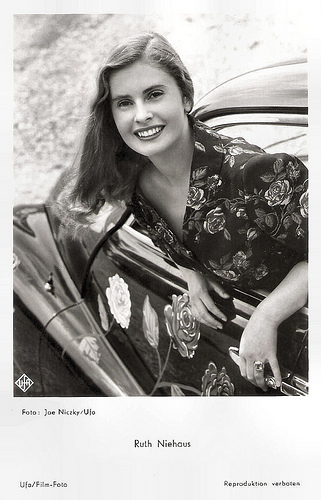
West-German postcard by Ufa, no. FK 2177. Photo: Joe Niczky / Ufa.
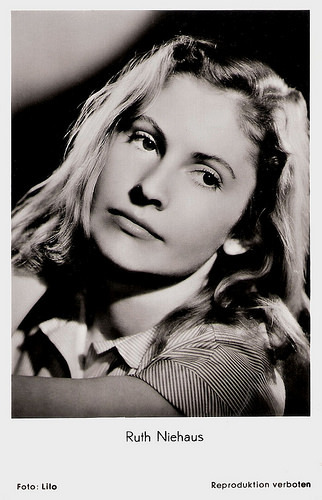
West-German postcard by Rüdel-Verlag, Hamburg-Bergedorf, no. 1297. Photo: Lilo.
Sources: Wikipedia (English and German) and .

West-German postcard by Kunst und Bild, Berlin, no. I 452. Photo: CCC-Film / Constantin-Film / Grimm. Publicity still for Studentin Helen Willfüer/Helene Willfüer (Rudolf Jugert, 1956).

West-German postcard by Ufa, Berlin-Tempelhof, no. FK 4113. Photo: Lilo.
Young, attractive, modern, self-confident and desirable
Ruth Hildegard Rosemarie Niehaus was born in 1925 in Krefeld, Germany. Her parents were Elisabeth Niehaus, born Nettesheim, and the engineer Fritz Niehaus. Her brother was the Munich surgeon Helmut Niehaus.
After completing her high school diploma in Dusseldorf, she attended the drama school there under Peter Esser. Her stage career began at the Stadttheater Krefeld in 1947-1948, followed by engagements at the Deutsche Schauspielhaus in Hamburg (1948-1949), at the Oldenburgische Staatstheater (1949-1950) and in Düsseldorf under the direction of Gustav Gründgens (1952-1954). She played both in classical and modern theatre.
The press called Niehaus a ‘Fräuleinwunder’ a term for young, attractive, modern, self-confident and desirable women of post-war Germany. In 1950 Ruth Niehaus reputedly spurned a marriage proposal from Orson Welles , and with it the chance to work in Hollywood. She did marry Ivar Lissner, a Jewish German journalist and best-selling author, who had been a spy with the German Abwehr during World War II.
Niehaus made her film debut in the West-German comedy Das Haus in Montevideo/The House in Montevideo (1951). It was directed by Curt Goetz and Valérie von Martens who also played the leads, while Niehaus played their daughter. The film is an adaptation of Goetz's 1945 comic play of the same name and Goetz and von Martens had already frequently played their parts on stage.
Niehaus next played a supporting part in Heidelberger Romanze/A Heidelberg Romance (Paul Verhoeven, 1951) starring Liselotte Pulver , O.W. Fischer and Gardy Granass .
She then had the lead in the Heimatfilm Rosen blühen auf dem Heidegrab/Roses Bloom on the Moorland (Hans H. König, 1952). Wikipedia : “This unusually gloomy Heimatfilm, which clearly stood out from the ‘Kinokonfektion’ of the era, is one of the high points in Niehaus's film career.”
She then co-starred with Ivan Desny and René Deltgen in the drama Weg ohne Umkehr/No Way Back (Victor Vicas, 1953). It was made at the height of the Cold War. In 1945 following the Battle of Berlin, a Red Army officer (Desny) is able to protect a young German woman (Niehaus) he finds living in a cellar. Several years later he returns to the city as a civilian, finds her again and makes plans to flee from East to West Germany under the noses of the KGB. For this role she won in 1954 the Bundesfilmpreis (German Film Award).
Other films followed, such as Rosenmontag/Love's Carnival (Willy Birgel, 1955) with Dietmar Schönherr , and Auferstehung/Resurrection (Rolf Hansen, 1958) starring Horst Buchholz .

West-German postcard by Kolibri-Verlag, no. 693. Photo: Panorama-Film / Königfilm / Hochreiter. Publicity still for Rosen blühen auf dem Heidegrab/Roses Bloom on the Moorland (Hans H. König, 1952) with Armin Dahlen.

German postcard by Franz Josef Rüdel, Filmpostkartenverlag Hamburg-Bergedorf, no. M 2482. Photo: Ringpress / Vogelmann / Bavaria. Publicity stills for Auferstehung/Resurrection (Rolf Hansen, 1958) with Horst Buchholz , Myriam Bru , Ruth Niehaus and Günther Lüders.
Das deutsche Gretchen 1959
In 1959, Ruth Niehaus co-starred with Helmuth Schneider in the Argentine film Cavalcade (Albert Arliss, Richard von Schenk, 1960). At the beginning of the 1960s Niehaus largely withdrew from the film business and only sporadically took on roles in film and television productions.
In 1980, she played a supporting part in the West German drama Fabian (Wolf Gremm, 1980), based on the novel by Erich Kästner. On television she played guest roles in Krimi series like Der Alte/The Old Fox (1978) and Tatort (1983).
Her main focus was on the theatre. At the Festival in Bad Hersfeld, she was celebrated as ‘Das deutsche Gretchen 1959’ in Goethe's Faust under the direction of William Dieterle . In 1961 and 1962, she also played Titania in Shakespeare's A Midsummer Night’s Dream, directed by Dieterle.
From 1964 to 1968 she worked under the direction of Oscar Fritz Schuh at the Deutsche Schauspielhaus Hamburg. In Hamburg, she brought the present author Jean Cocteau to tears with her depiction of Eurydice in his play Orpheus. These years at the Deutsche Schauspielhaus in Hamburg were her most successful stage period.
In 1968, she left the house together with Oscar Fritz Schuh and performed further roles in his productions. Until his death in 1984, Schuh was one of her closest friends.
In 1987, Ruth Niehaus was able to celebrate her 40th stage jubilee. That year she also directed Rebecca at the Münchner Kammerspielen. She remained on stage until 1992.
She incidentally played in films, such as in Hard Days, Hard Nights (Horst Königstein, 1989) with Al Corley. Her last film role was in Wir können auch anders/We can also differently (Detlev Buck, 1992).
In 1994 she and Christa Auch-Schwelk were honoured for their documentary Jeffrey – Zwischen Leben und Tod/Jeffrey – Between Life and Death with the media award of the AIDS-Stiftung (German AIDS Foundation).
Ruth Niehaus died in 1994 in Hamburg. She was 69. She and her husband Ivar Lissner, who passed away in 1965, had a daughter Imogen (now Imogen Jochem).

West-German postcard by Ufa, no. FK 2177. Photo: Joe Niczky / Ufa.

West-German postcard by Rüdel-Verlag, Hamburg-Bergedorf, no. 1297. Photo: Lilo.
Sources: Wikipedia (English and German) and .
Published on August 20, 2017 22:00
August 19, 2017
Harry Hardt
Austrian actor Harry Hardt (1899-1980) had a long career both in films and on television. He was a popular and extremely busy character player, who was generally cast as authority figures: police inspectors, officers and aristocrats.
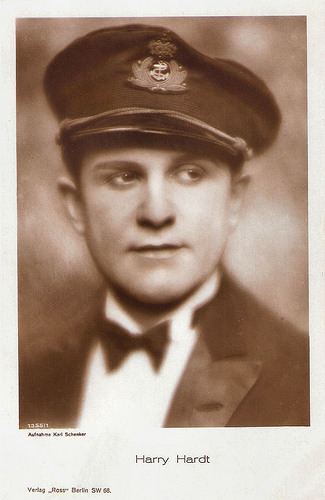
German postcard by Ross Verlag, no. 1355/1, 1927-1928. Photo: Atelier Karl Schenker.
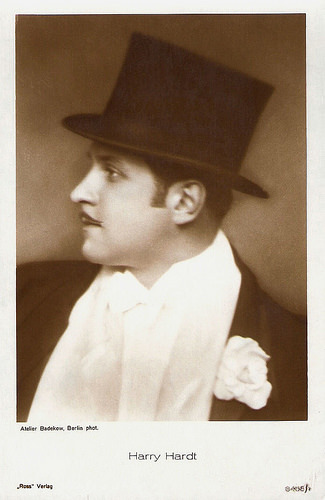
German postcard by Ross Verlag, no. 8406/1, 1933-1934. Atelier Badekow, Bertlin.
Officer and a Gentleman
Harry Hardt was born Hermann Karl Viktor Klimbacher Edler von Reichswahr in Pola, Küstenland, Austria-Hungary (now Pula, Istria, Croatia) in 1899. Hardt came from an aristocratic family with a strong military tradition. His father was an officer.
Deferring to his father's wishes, Harry dropped out of art history studies to undergo officer training at a military academy. During the First World War, he concluded that a military career was useless and he chose for acting.
After drama lessons in Graz and Berlin, he made his stage debut in 1919 at the Theater in Olmütz (now Czech Republic). From 1920 he played at the Trianon-Theater in Berlin. In the same year, the handsome actor made his first film appearance in the silent production Die Frauen vom Gnadenstein/The Women of Gnadenstein (Robert Dinesen, Joe May, 1920), for which Thea von Harbau had written the script.
Soon he became a frequently used character actor in such melodramas as Die Opiumhölle/The opium hell (Siegfried Dessauer, 1921), Paganini (Heinz Goldberg, 1923) with Conrad Veidt , and Der Klabautermann (Paul Merzbach, 1924) with Evi Eva . At first Hardt played gallant young lovers, and later he turned to distinguished gentlemen with his Adolphe Menjou -like moustache.
His standard repertoire included noblemen like the Count in the romance Zopf und Schwert - Eine tolle Prinzessin/Braid and Sword - A great princess (Victor Janson, Rudolf Dworsky, 1926) starring Mady Christians , or the Prince in the drama Hochverrat/Treason (Johannes Meyer, 1929), smart lieutenants like the ones in Das edle Blut/The noble blood (Carl Boese, 1927), Ungarische Rhapsodie/Hungarian Rhapsody (Hanns Schwarz, 1928) with Willy Fritsch , and Es flüstert die Nacht/It whispers the night (Victor Janson, 1929), starring Lil Dagover .
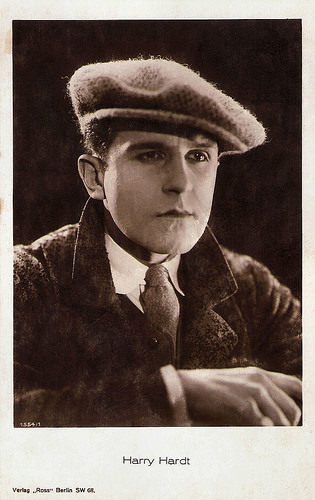
German postcard by Ross Verlag, no. 1554/1, 1927-1928.
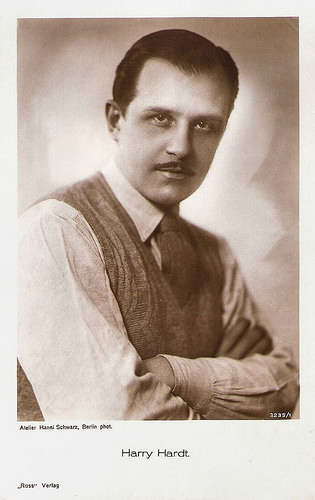
German postcard by Ross Verlag, no. 3235/1, 1928-1929. Photo: Atelier Hanni Schwarz, Berlin.
Hitchcock
Harry Hardt was much in demand by directors and producers, but nevertheless he never became a big star. In the early sound years, he acted in Der Greifer/The Copper (Richard Eichberg, 1930) at Hans Albers ' side, and in Alfred Hitchcock’s thriller Mary/Murder (1931).
Both films were shot concurrently in German- and English-language versions. After the introduction of sound film this was a fairly common practice both in Hollywood and in the European cinema when it was not yet common practice to overdub dialogues.
In the following years Hardt played a hotel director in Zigeunerblut/Gypsy Blood (Charles Klein, 1934) starring Adele Sandrock, a captain in both Abenteuer eines jungen Herrn in Polen/Love and Alarm (Gustav Fröhlich, 1934) and Schwarzer Jäger Johanna/Black Fighter Johanna (Johannes Meyer, 1934) featuring Marianne Hoppe , and a hotel porter in Barcarole (Gerhard Lamprecht, 1935).
In the mystery comedy Der Mann, der Sherlock Holmes war/The Man Who Was Sherlock Holmes (Karl Hartl, 1937), he played a gambler, who is impressed by a detective ( Hans Albers ) who masquerades as Sherlock Holmes. During the war years he played small roles in Austrian and German films, including the colour spectacle Münchhausen (Josef von Báky, 1943), again starring Hans Albers .
After the war he kept appearing in supporting parts as aristocrats or professors in historical films like Kaiserwalzer/The Emperor Waltz (Franz Antel, 1953) with Maria Holst as Kaiserin Elisabeth von Österreich, Ewiger Walzer/The Eternal Waltz (Paul Verhoeven, 1954), with Bernhard Wicki as composer Johann Strauss II, and Um Thron und Liebe/Sarajevo (Fritz Kortner, 1955), which portrays the assassination of Archduke Franz Ferdinand of Austria in 1914.
During the 1960s and 1970s he often appeared on television in such series as the Krimi Derrick (1978). Incidentally he appeared in films, e.g. in the sex comedy Komm nach Wien, ich zeig dir was!/Come to Vienna, I'll show you something! (Rolf Thiele, 1970), and the ethereal, three-hour biopic Karl May (Hans-Jürgen Syberberg, 1974), with Helmut Käutner as the author of Winnetou. His final film was Egon Schiele - Exzesse (Herbert Vesely, 1981) with Mathieu Carrière as the cursed painter Egon Schiele.
In total Harry Hardt appeared in 180 feature films, and also in numerous television productions. In the series Königlich Bayerisches Amtsgericht he appeared several times as Count von Haunsperg. At the end of his career, he again intensified his theatrical work. In 1980, Harry Hardt died in Vienna, Austria. He was 81.
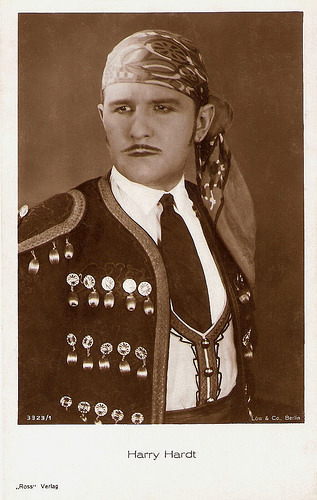
German postcard by Ross Verlag, no. 3323/1, 1928-1929. Photo: Low & Co., Berlin.
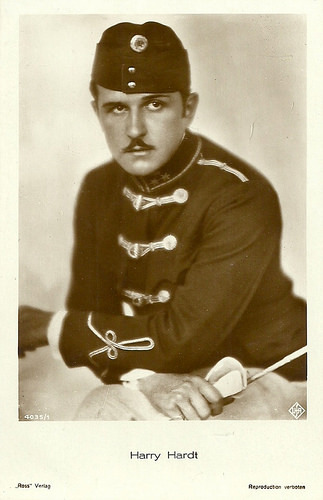
German postcard. Ross Verlag, no. 4035/1, 1929-1930. Photo: Ufa. It could be a still for the film Ungarische Rhapsodie (Hanns Schwarz, 1928).
Sources: Stephanie D’heil (Steffi-Line – German), Thomas Staedeli (Cyranos), Filmportal.de, Wikipedia (German and English) and .

German postcard by Ross Verlag, no. 1355/1, 1927-1928. Photo: Atelier Karl Schenker.

German postcard by Ross Verlag, no. 8406/1, 1933-1934. Atelier Badekow, Bertlin.
Officer and a Gentleman
Harry Hardt was born Hermann Karl Viktor Klimbacher Edler von Reichswahr in Pola, Küstenland, Austria-Hungary (now Pula, Istria, Croatia) in 1899. Hardt came from an aristocratic family with a strong military tradition. His father was an officer.
Deferring to his father's wishes, Harry dropped out of art history studies to undergo officer training at a military academy. During the First World War, he concluded that a military career was useless and he chose for acting.
After drama lessons in Graz and Berlin, he made his stage debut in 1919 at the Theater in Olmütz (now Czech Republic). From 1920 he played at the Trianon-Theater in Berlin. In the same year, the handsome actor made his first film appearance in the silent production Die Frauen vom Gnadenstein/The Women of Gnadenstein (Robert Dinesen, Joe May, 1920), for which Thea von Harbau had written the script.
Soon he became a frequently used character actor in such melodramas as Die Opiumhölle/The opium hell (Siegfried Dessauer, 1921), Paganini (Heinz Goldberg, 1923) with Conrad Veidt , and Der Klabautermann (Paul Merzbach, 1924) with Evi Eva . At first Hardt played gallant young lovers, and later he turned to distinguished gentlemen with his Adolphe Menjou -like moustache.
His standard repertoire included noblemen like the Count in the romance Zopf und Schwert - Eine tolle Prinzessin/Braid and Sword - A great princess (Victor Janson, Rudolf Dworsky, 1926) starring Mady Christians , or the Prince in the drama Hochverrat/Treason (Johannes Meyer, 1929), smart lieutenants like the ones in Das edle Blut/The noble blood (Carl Boese, 1927), Ungarische Rhapsodie/Hungarian Rhapsody (Hanns Schwarz, 1928) with Willy Fritsch , and Es flüstert die Nacht/It whispers the night (Victor Janson, 1929), starring Lil Dagover .

German postcard by Ross Verlag, no. 1554/1, 1927-1928.

German postcard by Ross Verlag, no. 3235/1, 1928-1929. Photo: Atelier Hanni Schwarz, Berlin.
Hitchcock
Harry Hardt was much in demand by directors and producers, but nevertheless he never became a big star. In the early sound years, he acted in Der Greifer/The Copper (Richard Eichberg, 1930) at Hans Albers ' side, and in Alfred Hitchcock’s thriller Mary/Murder (1931).
Both films were shot concurrently in German- and English-language versions. After the introduction of sound film this was a fairly common practice both in Hollywood and in the European cinema when it was not yet common practice to overdub dialogues.
In the following years Hardt played a hotel director in Zigeunerblut/Gypsy Blood (Charles Klein, 1934) starring Adele Sandrock, a captain in both Abenteuer eines jungen Herrn in Polen/Love and Alarm (Gustav Fröhlich, 1934) and Schwarzer Jäger Johanna/Black Fighter Johanna (Johannes Meyer, 1934) featuring Marianne Hoppe , and a hotel porter in Barcarole (Gerhard Lamprecht, 1935).
In the mystery comedy Der Mann, der Sherlock Holmes war/The Man Who Was Sherlock Holmes (Karl Hartl, 1937), he played a gambler, who is impressed by a detective ( Hans Albers ) who masquerades as Sherlock Holmes. During the war years he played small roles in Austrian and German films, including the colour spectacle Münchhausen (Josef von Báky, 1943), again starring Hans Albers .
After the war he kept appearing in supporting parts as aristocrats or professors in historical films like Kaiserwalzer/The Emperor Waltz (Franz Antel, 1953) with Maria Holst as Kaiserin Elisabeth von Österreich, Ewiger Walzer/The Eternal Waltz (Paul Verhoeven, 1954), with Bernhard Wicki as composer Johann Strauss II, and Um Thron und Liebe/Sarajevo (Fritz Kortner, 1955), which portrays the assassination of Archduke Franz Ferdinand of Austria in 1914.
During the 1960s and 1970s he often appeared on television in such series as the Krimi Derrick (1978). Incidentally he appeared in films, e.g. in the sex comedy Komm nach Wien, ich zeig dir was!/Come to Vienna, I'll show you something! (Rolf Thiele, 1970), and the ethereal, three-hour biopic Karl May (Hans-Jürgen Syberberg, 1974), with Helmut Käutner as the author of Winnetou. His final film was Egon Schiele - Exzesse (Herbert Vesely, 1981) with Mathieu Carrière as the cursed painter Egon Schiele.
In total Harry Hardt appeared in 180 feature films, and also in numerous television productions. In the series Königlich Bayerisches Amtsgericht he appeared several times as Count von Haunsperg. At the end of his career, he again intensified his theatrical work. In 1980, Harry Hardt died in Vienna, Austria. He was 81.

German postcard by Ross Verlag, no. 3323/1, 1928-1929. Photo: Low & Co., Berlin.

German postcard. Ross Verlag, no. 4035/1, 1929-1930. Photo: Ufa. It could be a still for the film Ungarische Rhapsodie (Hanns Schwarz, 1928).
Sources: Stephanie D’heil (Steffi-Line – German), Thomas Staedeli (Cyranos), Filmportal.de, Wikipedia (German and English) and .
Published on August 19, 2017 22:00
August 18, 2017
Vom Werden deutscher Filmkunst, Part 3
In the early 1920s, the Weimar Republic faced numerous problems, including hyperinflation and political extremism. But the German film industry thrived and seemed to produce an endless stream of silent masterpieces. In the third post on our (incomplete) series of collectors cards of Vom Werden deutscher Filmkunst pictures of such classics as Der Golem (1920) with Paul Wegener, Faust (1926) with Emil Jannings and Dr. Mabuse, der Spieler (1922) with Rudolf Klein-Rogge. Ross Verlag published the collectors card series in 1935 for the 'Cigaretten-Bilderdienst', Altona-Bahrenfeld.
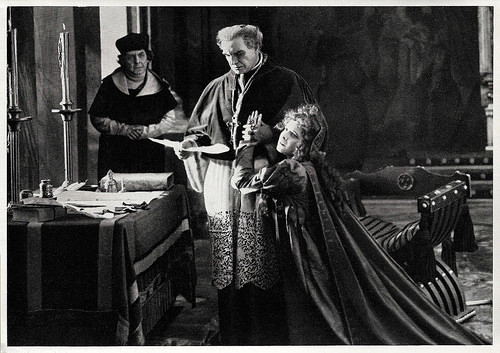
Liane Haid and Albert Bassermann in Lucrezia Borgia (1922). German collectors card by Ross Verlag in the series Vom Werden deutscher Filmkunst - Der Stumme Film, picture no. 71, group 40. Photo: Ufa. Publicity still with Liane Haid as Lucretia Borgia and Albert Bassermann as pope Alexander VI Rodrigo Borgia in Lucrezia Borgia/Lucretia Borgia (Richard Oswald, 1922).
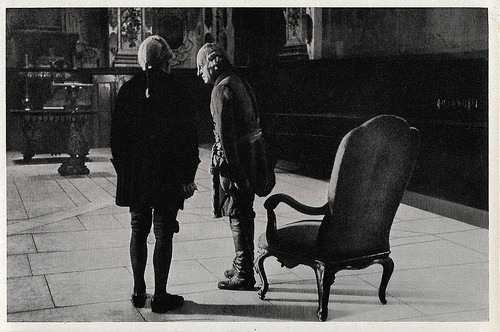
Otto Gebühr in Fridericus Rex (1922). German collectors card by Ross Verlag in the series Vom Werden deutscher Filmkunst - Der Stumme Film, picture no. 73, group 43. Photo: Ufa. Publicity still for Fridericus Rex (Arzén von Cserépy, 1922).
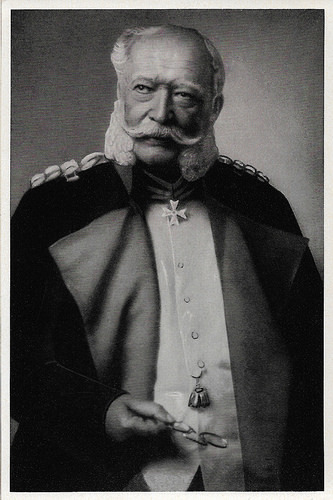
Adolf Klein in Bismarck, 1. Teil (1925). German collectors card by Ross Verlag in the series Vom Werden deutscher Filmkunst - Der Stumme Film, picture no. 77, group 43. Photo: Bismarck-Film. Publicity still for Bismarck, 1. Teil/Bismarck, Part 1 (Ernst Wendt, 1925) with Adolf Klein as Kaiser Wilhelm I.
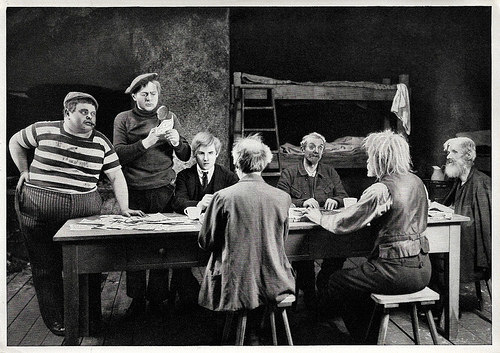
Rudolf Klein-Rogge and Károly Huszár in Dr. Mabuse, der Spieler (1922). German collectors card by Ross Verlag in the series Vom Werden deutscher Filmkunst - Der Stumme Film, picture no. 80, group 40. Photo: Ufa. Publicity still with Károly Huszár (left) and Rudolf Klein-Rogge (second from left) in Dr. Mabuse, der Spieler/Dr. Mabuse, King of Crime (Fritz Lang, 1922). Caption: Dr. Mabuse, who prints false money, lets the false notes sort by blind people who can not betray him.
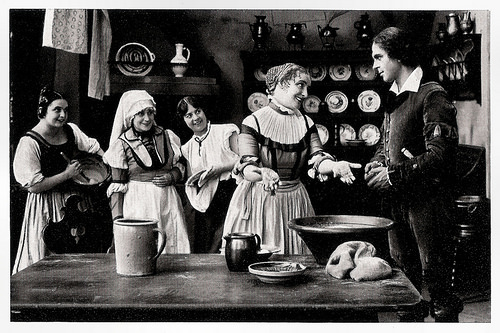
Henny Porten and Paul Hartmann in Monika Vogelsang (1920). German collectors card by Ross Verlag in the series Vom Werden deutscher Filmkunst - Der Stumme Film, picture, picture no, 81, group 43. Photo: Ufa. Publicity still for Monika Vogelsang (Rudolf Biebrach, 1920).
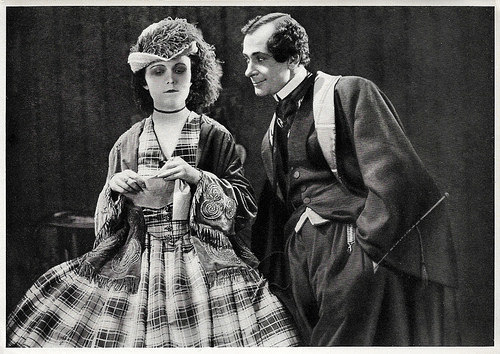
Pola Negri and Alfred Abel in Die Flamme (1923). German collectors card by Ross Verlag in the series Vom Werden deutscher Filmkunst - Der Stumme Film, picture no. 83, group 40. Photo: Ufa. Publicity still for Die Flamme/The Flame (Ernst Lubitsch, 1923).
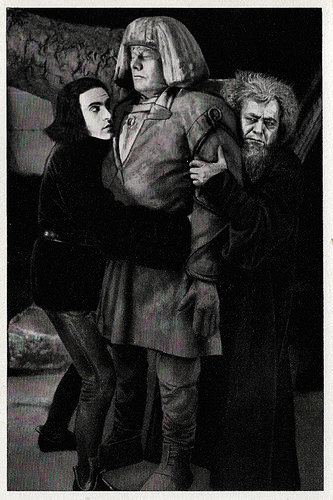
Paul Wegener , Albert Steinrück and Ernst Deutsch in Der Golem, wie er in die Welt kam (1920). German collectors card by Ross Verlag in the series Vom Werden deutscher Filmkunst - Der Stumme Film, picture no. 87, group 43. Photo: Ufa. Publicity still for Der Golem, wie er in die Welt kam/The Golem: How He Came Into the World (Carl Boese, Paul Wegener, 1920). Caption: Paul Wegener as Golem, Albert Steinrück as Rabbi Loew, Ernst Deutsch as Famulus.
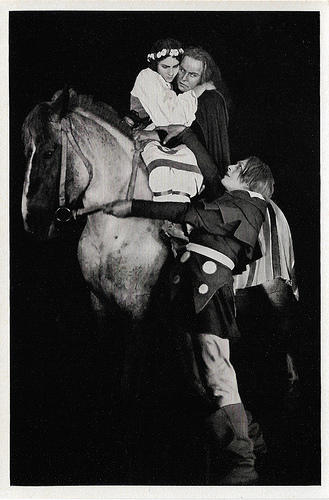
Rudolf Klein-Rogge and Lucie Mannheim in Der steinerne Reiter (1923). German collectors card by Ross Verlag in the series Vom Werden deutscher Filmkunst - Der Stumme Film, picture, picture no. 90, group 43. Photo: Decla-Film. Publicity still for Der steinerne Reiter/The Stone Rider (Fritz Wendhausen, 1923).
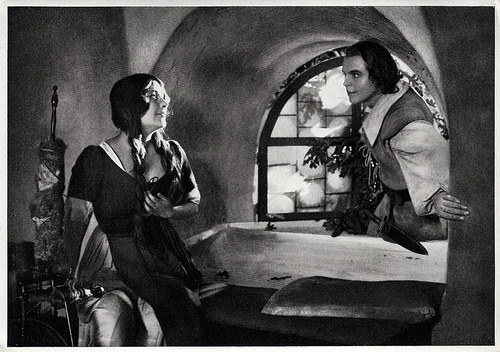
Lil Dagover and Paul Hartmann in Zur Chronik von Grieshuus (1925). German collectors card by Ross Verlag in the series Vom Werden deutscher Filmkunst - Der Stumme Film, picture no. 91, group 40. Photo: Ufa. Publicity still for Zur Chronik von Grieshuus/The Chronicles of the Gray House ( Arthur von Gerlach, 1925).
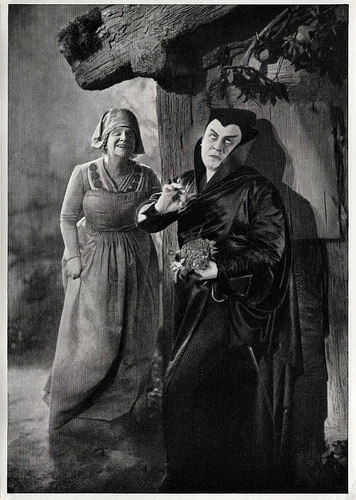
Yvette Guilbert and Emil Jannings in Faust (1926). German collectors card by Ross Verlag in the series Vom Werden deutscher Filmkunst - Der Stumme Film, picture no. 94, group 40. Photo: Ufa. Publicity still with Emil Jannings as Mephisto and Yvette Guilbert as Marthe in Faust (Friedrich Wilhelm Murnau, 1926).
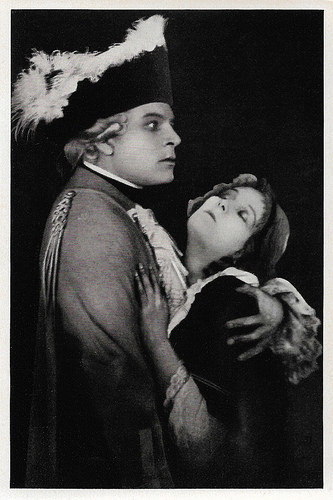
Paul Hartmann and Lil Dagover in Luise Millerin (1922). German collectors card by Ross Verlag in the series Vom Werden deutscher Filmkunst - Der Stumme Film, picture no. 96, group 43. Photo: Decla-Film. Publicity still for Luise Millerin (1922).
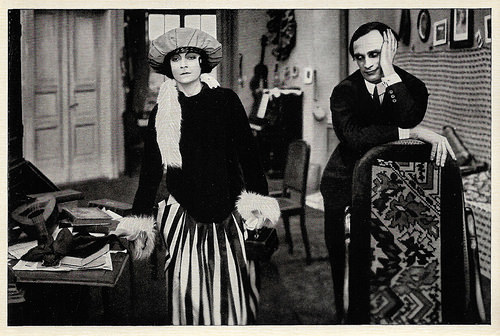
Asta Nielsen and Conrad Veidt in Der Reigen - Ein Werdegang (1920). German collectors card by Ross Verlag in the series Vom Werden deutscher Filmkunst - Der Stumme Film, picture no. 98. Photo: Ufa. Publicity still for Der Reigen - Ein Werdegang/The Merry-Go-Round (Richard Oswald, 1920).
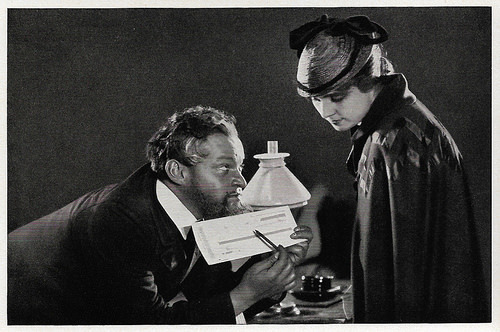
Fritz Kortner and Olga Tschechowa in Nora (1923). German collectors card by Ross Verlag in the series Vom Werden deutscher Filmkunst - Der Stumme Film, picture no. 99, group 43. Photo: Ufa. Publicity still for Nora (Berthold Viertel, 1923).
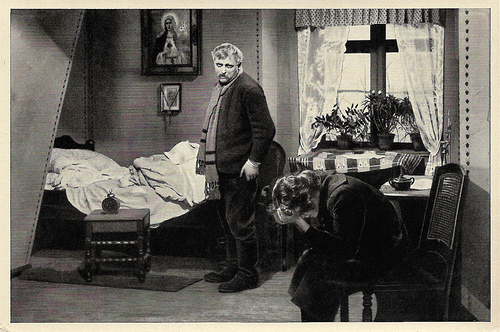
Werner Krauss in Scherben (1921). German collectors card by Ross Verlag in the series Vom Werden deutscher Filmkunst - Der Stumme Film, picture no. 101. Photo: Ufa. Publicity still with Werner Krauss in the classic German Kammerspiel film Scherben/Shattered (Lupu Pick, 1921). The woman is Edith Posca, who plays the daughter.
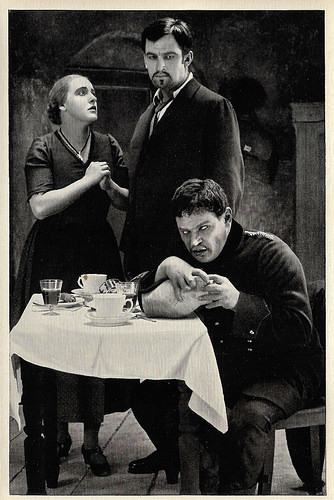
Henny Porten , Wilhelm Dieterle and Fritz Kortner in Hintertreppe (1921). German collectors card by Ross Verlag in the series Vom Werden deutscher Filmkunst - Der Stumme Film, picture no. 102. Photo: Ufa. Publicity still for Hintertreppe/Backstairs (Leopold Jessner, Paul Leni, 1921).
To be continued next Saturday!

Liane Haid and Albert Bassermann in Lucrezia Borgia (1922). German collectors card by Ross Verlag in the series Vom Werden deutscher Filmkunst - Der Stumme Film, picture no. 71, group 40. Photo: Ufa. Publicity still with Liane Haid as Lucretia Borgia and Albert Bassermann as pope Alexander VI Rodrigo Borgia in Lucrezia Borgia/Lucretia Borgia (Richard Oswald, 1922).

Otto Gebühr in Fridericus Rex (1922). German collectors card by Ross Verlag in the series Vom Werden deutscher Filmkunst - Der Stumme Film, picture no. 73, group 43. Photo: Ufa. Publicity still for Fridericus Rex (Arzén von Cserépy, 1922).

Adolf Klein in Bismarck, 1. Teil (1925). German collectors card by Ross Verlag in the series Vom Werden deutscher Filmkunst - Der Stumme Film, picture no. 77, group 43. Photo: Bismarck-Film. Publicity still for Bismarck, 1. Teil/Bismarck, Part 1 (Ernst Wendt, 1925) with Adolf Klein as Kaiser Wilhelm I.

Rudolf Klein-Rogge and Károly Huszár in Dr. Mabuse, der Spieler (1922). German collectors card by Ross Verlag in the series Vom Werden deutscher Filmkunst - Der Stumme Film, picture no. 80, group 40. Photo: Ufa. Publicity still with Károly Huszár (left) and Rudolf Klein-Rogge (second from left) in Dr. Mabuse, der Spieler/Dr. Mabuse, King of Crime (Fritz Lang, 1922). Caption: Dr. Mabuse, who prints false money, lets the false notes sort by blind people who can not betray him.

Henny Porten and Paul Hartmann in Monika Vogelsang (1920). German collectors card by Ross Verlag in the series Vom Werden deutscher Filmkunst - Der Stumme Film, picture, picture no, 81, group 43. Photo: Ufa. Publicity still for Monika Vogelsang (Rudolf Biebrach, 1920).

Pola Negri and Alfred Abel in Die Flamme (1923). German collectors card by Ross Verlag in the series Vom Werden deutscher Filmkunst - Der Stumme Film, picture no. 83, group 40. Photo: Ufa. Publicity still for Die Flamme/The Flame (Ernst Lubitsch, 1923).

Paul Wegener , Albert Steinrück and Ernst Deutsch in Der Golem, wie er in die Welt kam (1920). German collectors card by Ross Verlag in the series Vom Werden deutscher Filmkunst - Der Stumme Film, picture no. 87, group 43. Photo: Ufa. Publicity still for Der Golem, wie er in die Welt kam/The Golem: How He Came Into the World (Carl Boese, Paul Wegener, 1920). Caption: Paul Wegener as Golem, Albert Steinrück as Rabbi Loew, Ernst Deutsch as Famulus.

Rudolf Klein-Rogge and Lucie Mannheim in Der steinerne Reiter (1923). German collectors card by Ross Verlag in the series Vom Werden deutscher Filmkunst - Der Stumme Film, picture, picture no. 90, group 43. Photo: Decla-Film. Publicity still for Der steinerne Reiter/The Stone Rider (Fritz Wendhausen, 1923).

Lil Dagover and Paul Hartmann in Zur Chronik von Grieshuus (1925). German collectors card by Ross Verlag in the series Vom Werden deutscher Filmkunst - Der Stumme Film, picture no. 91, group 40. Photo: Ufa. Publicity still for Zur Chronik von Grieshuus/The Chronicles of the Gray House ( Arthur von Gerlach, 1925).

Yvette Guilbert and Emil Jannings in Faust (1926). German collectors card by Ross Verlag in the series Vom Werden deutscher Filmkunst - Der Stumme Film, picture no. 94, group 40. Photo: Ufa. Publicity still with Emil Jannings as Mephisto and Yvette Guilbert as Marthe in Faust (Friedrich Wilhelm Murnau, 1926).

Paul Hartmann and Lil Dagover in Luise Millerin (1922). German collectors card by Ross Verlag in the series Vom Werden deutscher Filmkunst - Der Stumme Film, picture no. 96, group 43. Photo: Decla-Film. Publicity still for Luise Millerin (1922).

Asta Nielsen and Conrad Veidt in Der Reigen - Ein Werdegang (1920). German collectors card by Ross Verlag in the series Vom Werden deutscher Filmkunst - Der Stumme Film, picture no. 98. Photo: Ufa. Publicity still for Der Reigen - Ein Werdegang/The Merry-Go-Round (Richard Oswald, 1920).

Fritz Kortner and Olga Tschechowa in Nora (1923). German collectors card by Ross Verlag in the series Vom Werden deutscher Filmkunst - Der Stumme Film, picture no. 99, group 43. Photo: Ufa. Publicity still for Nora (Berthold Viertel, 1923).

Werner Krauss in Scherben (1921). German collectors card by Ross Verlag in the series Vom Werden deutscher Filmkunst - Der Stumme Film, picture no. 101. Photo: Ufa. Publicity still with Werner Krauss in the classic German Kammerspiel film Scherben/Shattered (Lupu Pick, 1921). The woman is Edith Posca, who plays the daughter.

Henny Porten , Wilhelm Dieterle and Fritz Kortner in Hintertreppe (1921). German collectors card by Ross Verlag in the series Vom Werden deutscher Filmkunst - Der Stumme Film, picture no. 102. Photo: Ufa. Publicity still for Hintertreppe/Backstairs (Leopold Jessner, Paul Leni, 1921).
To be continued next Saturday!
Published on August 18, 2017 22:00
August 17, 2017
Miriam Jordan
Beautiful, British Miriam 'Mimi' Jordan (1904-1987) enjoyed a brief career in Hollywood as a leading lady during the early 1930s. Her best known films are Sherlock Holmes (1932) and I Loved You Wednesday (1933), but most of her work was confined to the stage.
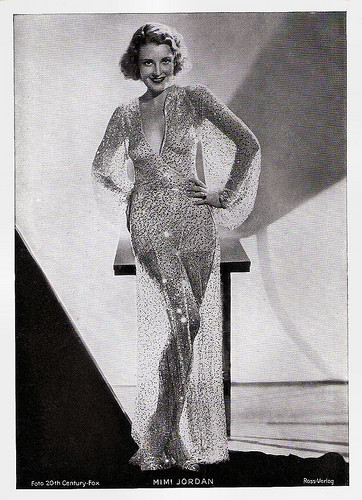
Big German card by Ross Verlag. Photo: 20th Century Fox.
Sherlock Holmes
Miriam Jordan, also known as Mimi Jordan, was born in 1904, in London, England, UK. She won a beauty contest while working as a typist in London and this facilitated her introduction to the stage.
Seeking fame and fortune in America, she was 'decoratively cast' in the musical comedy Three Cheers (1928) with Will Rogers at the Globe Theatre at Broadway. Her one scene consisted of walking down stairs, while modelling a fabulous gown.
In 1931, she made her real Broadway debut in the drama Cynara, written by H.M. Harwood and R.F. Gore-Brown.
Between 1932 and 1934, she appeared in a handful of Hollywood films for 20th Century Fox. She co-starred with fading star Warner Baxter in her film debut, the Science Fiction drama 6 Hours to Live (William Dieterle, 1932) and again in Dangerously Yours (Frank Tuttle, 1933).
In the enjoyable detective film Sherlock Holmes (William K. Howard, 1932), Miriam and co-star Clive Brook were effectively upstaged by character actor Ernest Torrence in the part of Holmes's arch-rival, Professor Moriarty.
Miriam's best moment was to be the romance I Loved You Wednesday (Henry King, William Cameron Menzies, 1933) in which she was billed fourth (after Warner Baxter again, Elissa Landi and Victor Jory) in the part of Cynthia Williams. Mordaunt Hall in The New York Times called the film "an unusually handsome and interesting picture" and Miriam "charming"and her performance "splendid".
However, after the romantic comedy Two Heads on a Pillow (William Nigh, 1934) opposite Neil Hamilton, her days as a leading lady were over. Jordan later only returned in a bit part in My Own True Love (Compton Bennett, 1948). On Broadway, she appeared in 1938 in a short-lived run of Michael Drops In.
Miriam Jordan passed away in 1987, in Great Worley, England, UK.
Scene with Miriam Jordan, Clive Brook, Howard Leeds and Reginald Owen in Sherlock Holmes (1932). Source: (YouTube).
Sources: Mordaunt Hall (The New York Times), (IMDb), Wikipedia and .

Big German card by Ross Verlag. Photo: 20th Century Fox.
Sherlock Holmes
Miriam Jordan, also known as Mimi Jordan, was born in 1904, in London, England, UK. She won a beauty contest while working as a typist in London and this facilitated her introduction to the stage.
Seeking fame and fortune in America, she was 'decoratively cast' in the musical comedy Three Cheers (1928) with Will Rogers at the Globe Theatre at Broadway. Her one scene consisted of walking down stairs, while modelling a fabulous gown.
In 1931, she made her real Broadway debut in the drama Cynara, written by H.M. Harwood and R.F. Gore-Brown.
Between 1932 and 1934, she appeared in a handful of Hollywood films for 20th Century Fox. She co-starred with fading star Warner Baxter in her film debut, the Science Fiction drama 6 Hours to Live (William Dieterle, 1932) and again in Dangerously Yours (Frank Tuttle, 1933).
In the enjoyable detective film Sherlock Holmes (William K. Howard, 1932), Miriam and co-star Clive Brook were effectively upstaged by character actor Ernest Torrence in the part of Holmes's arch-rival, Professor Moriarty.
Miriam's best moment was to be the romance I Loved You Wednesday (Henry King, William Cameron Menzies, 1933) in which she was billed fourth (after Warner Baxter again, Elissa Landi and Victor Jory) in the part of Cynthia Williams. Mordaunt Hall in The New York Times called the film "an unusually handsome and interesting picture" and Miriam "charming"and her performance "splendid".
However, after the romantic comedy Two Heads on a Pillow (William Nigh, 1934) opposite Neil Hamilton, her days as a leading lady were over. Jordan later only returned in a bit part in My Own True Love (Compton Bennett, 1948). On Broadway, she appeared in 1938 in a short-lived run of Michael Drops In.
Miriam Jordan passed away in 1987, in Great Worley, England, UK.
Scene with Miriam Jordan, Clive Brook, Howard Leeds and Reginald Owen in Sherlock Holmes (1932). Source: (YouTube).
Sources: Mordaunt Hall (The New York Times), (IMDb), Wikipedia and .
Published on August 17, 2017 22:00
August 16, 2017
Naufragio (1916)
Italian child star Ermanno Roveri (1903-1968) played the lead in the silent melodrama Naufragio (Umberto Paradisi, 1916). Naufragio was part of a series of films based on the stories in Cuore (1886) by Edmondo De Amicis.
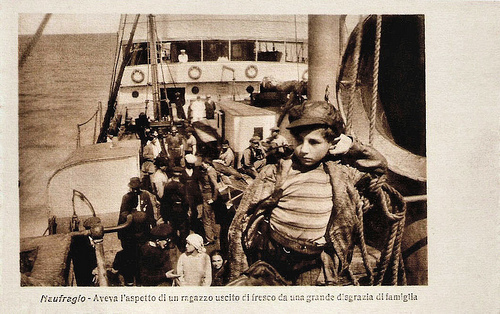
Italian postcard by Film Artistica Gloria, Torino (Turin), no. 3404. Printed by Uff. Rev. St. Terni, 16-5-17. Caption: He had the look of a boy who just came out of a big family misfortune.
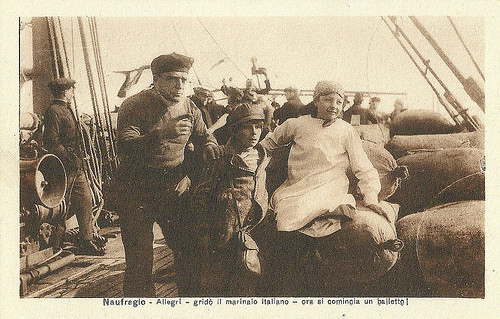
Italian postcard by Film Artistica Floria, Torino (Turin), no. 3404. Printed by Uff. Rev. St. Terni, 16-5-17. Caption: Be cheerful, the Italian sailor cried to them, now a ballet starts!
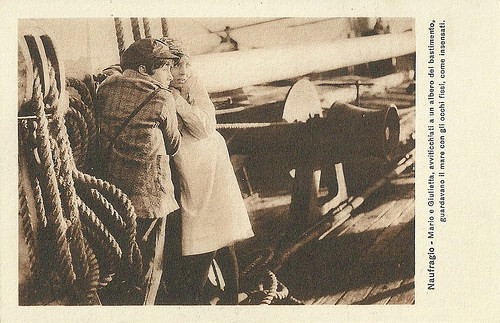
Italian postcard by Film Artistica Floria, Torino (Turin), no. 3404. Printed by Uff. Rev. St. Terni, 16-5-17. Caption: Curled up against the vessel's mast, Mario and Giulietta stared at the sea with fixed eyes, as if senseless.
An Orphan on a Sinking Ship
Ermanno Roveri played the Sicilian orphan Mario, who is repatriated from Liverpool to Sicily. On the boat he meets Giulietta (played by Ermanno’s sister, Lavinia Roveri), who has to return to her parents in Naples.
During a tempest the boat sinks and Mario offers his seat in the lifeboat to Giulietta. Mario drowns on the sinking ship.
Naufragio was a production of Gloria, the film company in Turin that also produced the first films of diva Lyda Borelli . Gloria produced a series of films based on the stories in Cuore (1886) by Edmondo De Amicis.
Roveri acted in many of these films, including Dagli Appennini alle Ande, Naufragio, Il piccolo patriota padovano and Il piccolo scrivano fiorentino.
Ermanno Roveri thus was one of the stars of Gloria. In 1913-1914 he had become famous as Frugolino, one of the comic child actors of the Cines company in Rome.
In the 1930s and 1940s Ermanno played in a dozen Italian films. He would continue to work in the theatre and incidentally in cinema or on television till his death in 1968.
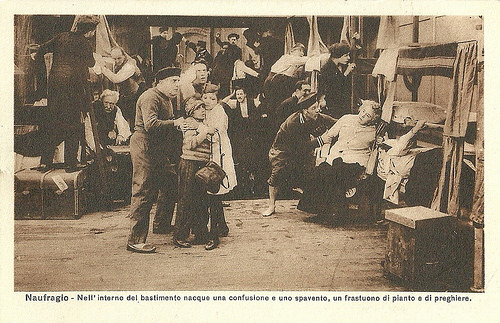
Italian postcard by Film Artistica Floria, Torino (Turin), no. 3404. Printed by Uff. Rev. St. Terni, 16-5-17. Caption: In the interior of the vessel a confusion started as well as fright, and an uproar of weeping and prayers.
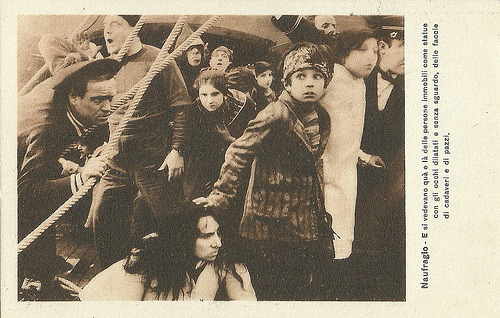
Italian postcard by Film Artistica Floria, Torino (Turin), no. 3404. Printed by Uff. Rev. St. Terni, 16-5-17. Caption: They saw all around them persons frozen like statues, with eyes wide open and with blank stares, with the faces of corpses and madmen.
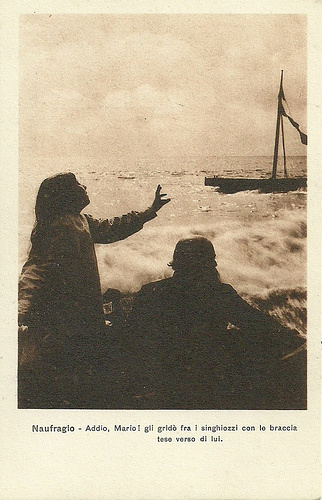
Italian postcard by Film Artistica Floria, Torino (Turin), no. 3404. Printed by Uff. Rev. St. Terni, 16-5-17. Caption: Goodbye, Mario!, she cried among her sobs with her arms extended towards him.
Sources: Vittorio Martinelli (Il Cinema Italiano 1916) and .

Italian postcard by Film Artistica Gloria, Torino (Turin), no. 3404. Printed by Uff. Rev. St. Terni, 16-5-17. Caption: He had the look of a boy who just came out of a big family misfortune.

Italian postcard by Film Artistica Floria, Torino (Turin), no. 3404. Printed by Uff. Rev. St. Terni, 16-5-17. Caption: Be cheerful, the Italian sailor cried to them, now a ballet starts!

Italian postcard by Film Artistica Floria, Torino (Turin), no. 3404. Printed by Uff. Rev. St. Terni, 16-5-17. Caption: Curled up against the vessel's mast, Mario and Giulietta stared at the sea with fixed eyes, as if senseless.
An Orphan on a Sinking Ship
Ermanno Roveri played the Sicilian orphan Mario, who is repatriated from Liverpool to Sicily. On the boat he meets Giulietta (played by Ermanno’s sister, Lavinia Roveri), who has to return to her parents in Naples.
During a tempest the boat sinks and Mario offers his seat in the lifeboat to Giulietta. Mario drowns on the sinking ship.
Naufragio was a production of Gloria, the film company in Turin that also produced the first films of diva Lyda Borelli . Gloria produced a series of films based on the stories in Cuore (1886) by Edmondo De Amicis.
Roveri acted in many of these films, including Dagli Appennini alle Ande, Naufragio, Il piccolo patriota padovano and Il piccolo scrivano fiorentino.
Ermanno Roveri thus was one of the stars of Gloria. In 1913-1914 he had become famous as Frugolino, one of the comic child actors of the Cines company in Rome.
In the 1930s and 1940s Ermanno played in a dozen Italian films. He would continue to work in the theatre and incidentally in cinema or on television till his death in 1968.

Italian postcard by Film Artistica Floria, Torino (Turin), no. 3404. Printed by Uff. Rev. St. Terni, 16-5-17. Caption: In the interior of the vessel a confusion started as well as fright, and an uproar of weeping and prayers.

Italian postcard by Film Artistica Floria, Torino (Turin), no. 3404. Printed by Uff. Rev. St. Terni, 16-5-17. Caption: They saw all around them persons frozen like statues, with eyes wide open and with blank stares, with the faces of corpses and madmen.

Italian postcard by Film Artistica Floria, Torino (Turin), no. 3404. Printed by Uff. Rev. St. Terni, 16-5-17. Caption: Goodbye, Mario!, she cried among her sobs with her arms extended towards him.
Sources: Vittorio Martinelli (Il Cinema Italiano 1916) and .
Published on August 16, 2017 22:00
Paul van Yperen's Blog
- Paul van Yperen's profile
- 13 followers
Paul van Yperen isn't a Goodreads Author
(yet),
but they
do have a blog,
so here are some recent posts imported from
their feed.



